The Mongols have four unique Ranged Cavalry units: the Nomad (II), Steppe Nomad (III), Horde (IV), and Golden Horde (V). Their listed benefit is that “they’re particularly effective against enemy Light Infantry” and “effective against enemy Musket Infantry”. The game confers these advantages by giving all four units a +60% damage bonus against Light Infantry and a +45% damage bonus against Gunpowder Infantry.
In reality this ends up being a really weird bonus to have. Not only do they still normally lose in fights against those units, but those same units are supposed to be counters to Ranged Cavalry, making these bonuses unintuitive for both the attacker and the defender.
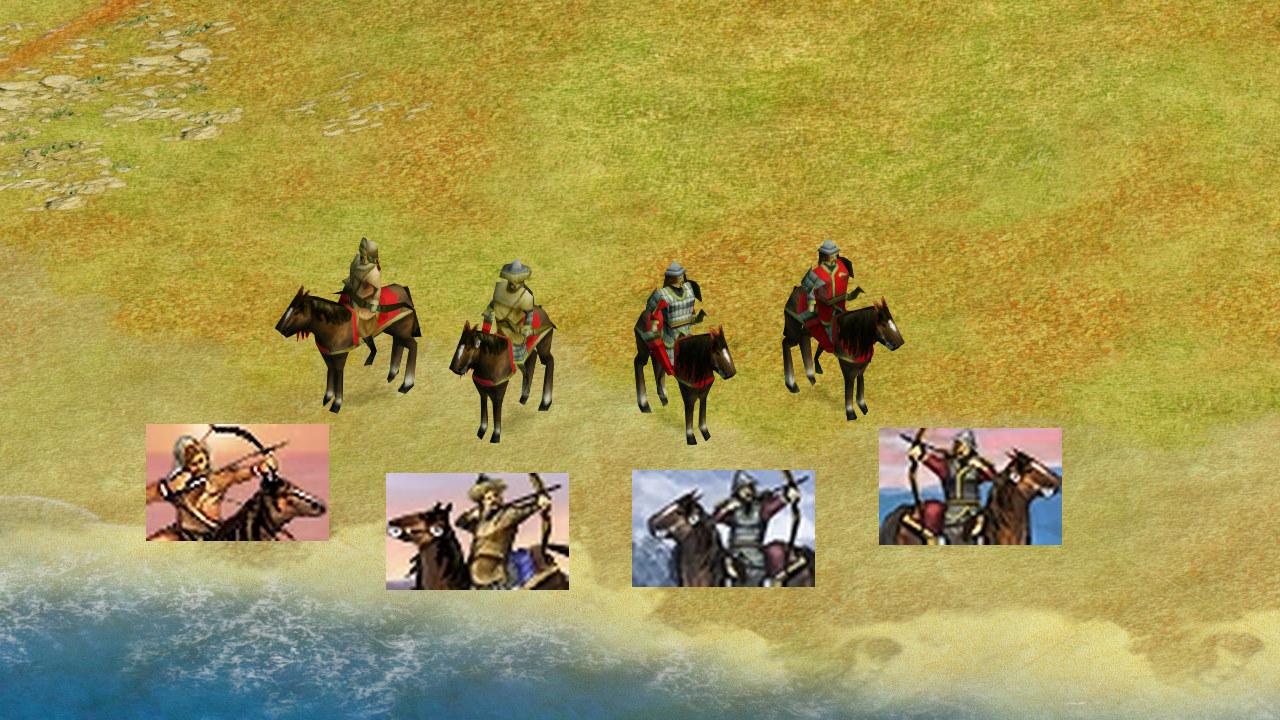
Update 2023-28-04: The Mongol’s nation power reduces the base cost of cavalry only, and does not affect the ramping cost. I believe I had incorrectly assumed that it affected the entire unit cost when I originally wrote this article. However, this impacts only small amounts of the article because I actually pulled the exact already-reduced cost values from the game instead of calculating them myself most of the times when cost is referenced. Since no in-line corrections have been made, it’s worth keeping this information in mind as you read.
First, let’s clarify a few things.
The above damage modifiers are not the only bonuses which the units have in practice. From nation powers they also have 10% reduced cost, 20% faster build times,1 and 50% reduced attrition. Although these benefits don’t come from the units themselves, they’re still important to keep in mind for the big picture perspective. The Mongols are the only nation that can build these units, so the nation power benefits are a package deal with the units themselves.
Secondly, Nomads (II) and Steppe Nomads (III) can fire 10 degrees further left and right than regular Horse Archers (II) and Heavy Horse Archers (III) can. For whatever reason, BHG did not assign that same bonus to the upgraded Horde (IV) or Golden Horde (V). Whether that was an intentional choice or not is anybody’s guess, and there’s not enough information in the game files or developer’s notes to know for sure.2
Whether the extra firing angle actually matters much or not is up for debate. The default angle for pre-Industrial ranged cav is 150 degrees, and almost all such ranged cav have this firing angle. While an extra 30 degrees is a significant and easily noticed bonus (being able to fire at units chasing it), an extra 10 degrees is much more difficult to evaluate and might never be noticed during normal usage.
It does seem weird for the units to lose firing angle when upgraded in IV though, particularly given that there’s no clear indicator that the unit’s any different (unlike with, say, the Mamluke (IV) losing attack angle when upgraded from the Heavy Chariot (III)).

There’s one final quirk of the Mongol UUs: they continue to use bows in IV and V, and they consequently have higher attack speed paired with much slower projectile speed when compared to the Dragoon and Carabineer.
Let’s talk matchups
Between Age II and Age V, if you put a Light Infantry / Gunpowder Infantry unit up against the same-age Horse Archer unit (colloquially: ranged cav), the former always wins.
To demonstrate this more visually, below is the result of those matchups. To reduce animation variance, each matchup was sampled a minimum of ten times and the median result was used for the screenshot.

As you can see, LI/GI soundly beat out HA in Ages II-V. The infantry units all end up at roughly half health after the fight.
Now let’s look at those same infantry matchups but against the Mongol UUs:
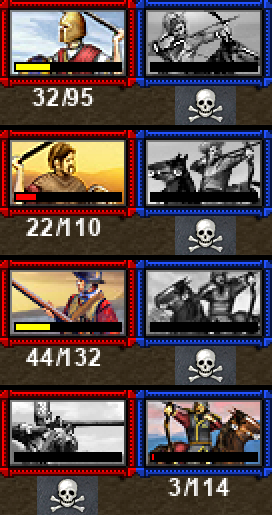
In 1v1 combat during Ages II-IV, the results are about what you’d expect — the bonus damage is enough to noticeably improve the matchup, but not enough to actually change the winner.
We then get to Age V and the result is — at least to me — extremely unexpected. By the skin of its teeth, a Golden Horde’s median result is killing a Musketeers squad and surviving with 3 HP. This is a staggeringly different result from the first test for only a +45% damage bonus.
As for why this happens, it seems to mostly come down to HP breakpoints on the infantry units. When attacking infantry squads, damage is dealt to individual sub-units, with each sub-unit effectively having its own hidden health bar.
When a sub-unit runs out of health, it dies, effectively cutting the squad’s damage output by one third. Killing a sub-unit even one attack earlier can have a significant effect on the result of a unit matchup because of this, and the Golden Hordes is able to reach the magic threshold where a Musketeer sub-unit is killed one shot early, thanks in part to Musketeers gaining an unusually low +10 HP bonus when upgraded from Arquebusiers in contrast to Golden Horde (V) gaining a more normal +2 attack over the prior Horde (IV).
If this were any other game, the article might be able to end here. The conclusion would be that Mongol UUs are still bad against the unit they have a bonus against — except in Age V where they can win by a tiny margin.
Unfortunately for my spare time, this is not any other game.
The effects of armor
Most of the time, adding armor evenly to both units in a 1v1 matchup has no significant effect on the result. It usually just makes the winner win harder, and the loser lose harder.
However, when it comes to magical breakpoints, armor can be significant — and we just saw how hitting a breakpoint can have a fairly drastic effect on the results of a 1v1 unit matchup. So here’s the median result of the same tests for standard units at both +2 and +4 armor, with the original +0 armor on the left side for easy reference:
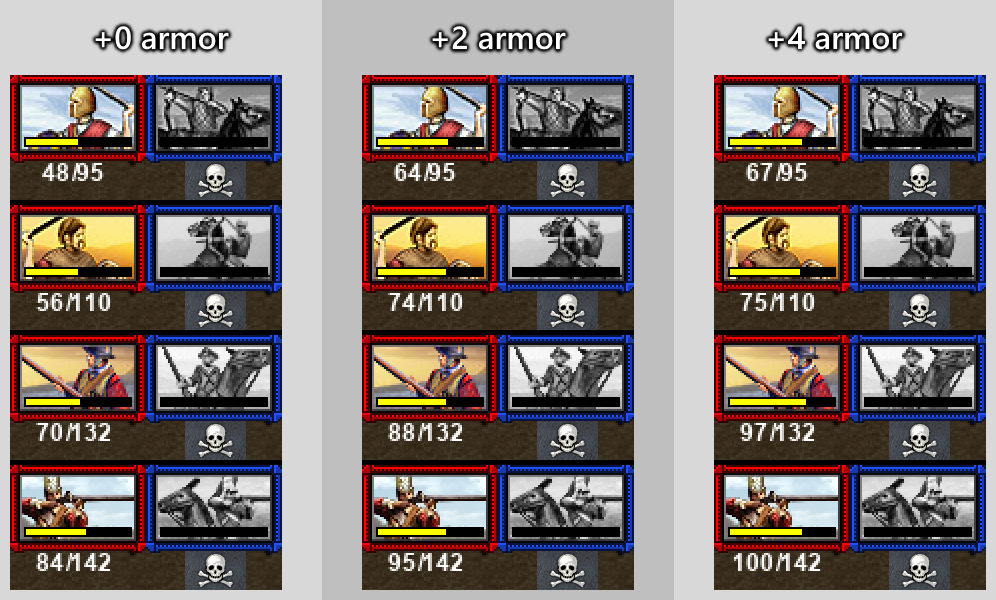
As you can see, adding either +2 or +4 armor to both units in the matchup follows the rule of thumb and the winners just win harder. It looks like +2 armor is enough to hit an important breakpoint for infantry sub-units in this specific matchup, and moving up to +4 armor has very little effect on the final health of the infantry in everything except the Arquebus matchup.
Now let’s do the same thing with the Mongol UUs:
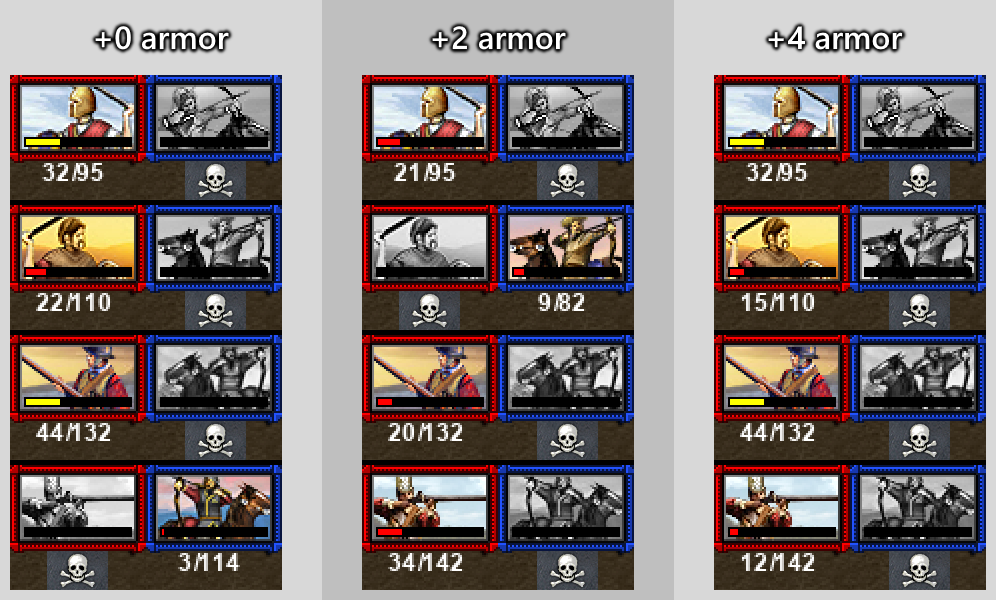
You can see that +2 armor for both sides has varied results, benefiting the Mongol UUs modestly in II-IV, but clearly letting Musketeers hit an important breakpoint in V.
Up at +4 armor the results are extremely close to those with no armor, to the point where both Javelineers and Arquebusiers have the same HP in the median result (and I did double-check that this wasn’t an error on my part). Musketeers flip their median outcome with the help of that armor boost, but the outcome remains close enough to still be decided by a single shot.
For time reasons I’ve skipped testing at +6 armor, but I also don’t think these particular tests are particularly valuable outside of theory.
Is armor even relevant in a 1v1?
All of that testing with armor is a useful informational backdrop, but actually misses the point.
Units very rarely engage in 1v1 combat with an armor bonus. There might be some 1v1 (or otherwise limited-unit) skirmishing during raids and such, but typically when a unit has an armor bonus, it’s because it’s part of an army.
On top of that, Light Infantry <-> Horse Archer is not a common matchup. Light Infantry pre-guns are the least useful of the six standard combat units and so are rarely used unless there’s no choice (e.g., during Age I). Horse Archers aren’t normally deployed in direct combat roles given that they cost as much as Foot Archers, yet deal less damage at a lower range. Their usage is instead mostly reserved for raiding, where their ability to fire while moving is a unique and significant advantage over other candidates, and where their fat bonus damage to civilians drastically increases their potential damage output.
For the two units to meet — alone — in a real game is itself rare. For them to do so with armor on top of that yet no other supporting units for either side is exceedingly unlikely.
So let’s focus on a more pragmatic scenario: army vs army combat in Age V. The reason why the units may be relevant here is because Foot Archers are gone (leaving only the somewhat less-direct competitor of Gunpowder Infantry) and Fusiliers significantly change how Heavy Cavalry can be used in fights, making the choice to build less heavy cav and more of the Mongol UUs a real consideration.
With Heavy Infantry and both Light and Heavy Cavalry being cut down first in fights, both Gunpowder Infantry and Horse Archers can be expected to be among the last units standing in a fight. Thus, a direct confrontation between the units is actually quite plausible. It’s also all-but-guaranteed that most army-vs-army combat in these ages will involve armor with Operations researched (+6 armor).
Here’s the setup for a 10v10 with these conditions:

To reduce the effects of good or bad rng, this fight is done five times. Minute variations in unit formations are used each time (which can affect which units get targeted and by how many units). Here are the results of all five:
For the Mongol UUs, these results are atrociously bad. Comically poor performance, barely able to kill half of the Musketeers in these samples. The first result even had no full-squad deaths, which would be a truly painful result as the Mongols player.
Closing the gap
The difference between that and the earlier results is not from height3 — I do army-vs-army tests perpendicular to the coastline specifically to mitigate the potential effects of height.
My first thought was that it may be because of the effects of projectile speed in army-vs-army combat. As I’ve discussed previously, a high projectile speed means both that overkilling units is less common and also “overkilled projectiles” are more likely to damage adjacent targets rather than be entirely wasted.
Golden Hordes normally have 100 projectile speed, so I changed it to 350 (the standard gun projectile speed, the same as what Musketeers have) and re-tested again three times with the same +6 armor:
So it seems to help a little, with a couple extra Musketeers squads being taken out in the typical result in our limited sample.
The second result is a great example of extreme bad luck (saying this as the person who watched the fight unfold). Multiple Musketeers got stuck at the back unable to shoot at anything (which is non-trivial thanks for non-linear army scaling), and when it came down to the last few units duking it out, a low-health Golden Horde was completely ignored in favor of one of its full-health brethren until it was the very last Golden Horde alive. So this specific result is a realistically-possible yet extremely unlucky outcome.
In any case, we can see that projectile speed by itself isn’t enough even out the two sides. My best theory explaining why the disparity between the 1v1 and 10v10 results occur is because the effect from having sub-units scales as-expected for infantry between 1v1s and 10v10. They go from 3 sub-units in the former to 30 sub-units in the latter. For cavalry and other single-unit-less.. units, they instead go from having no sub-unit penalty to effectively being a squad of 10 sub-units.
It might be easier to understand this effect by plotting the DPS loss of example infantry vs cavalry, and observing the DPS change as sub-units / units die (using made up numbers):
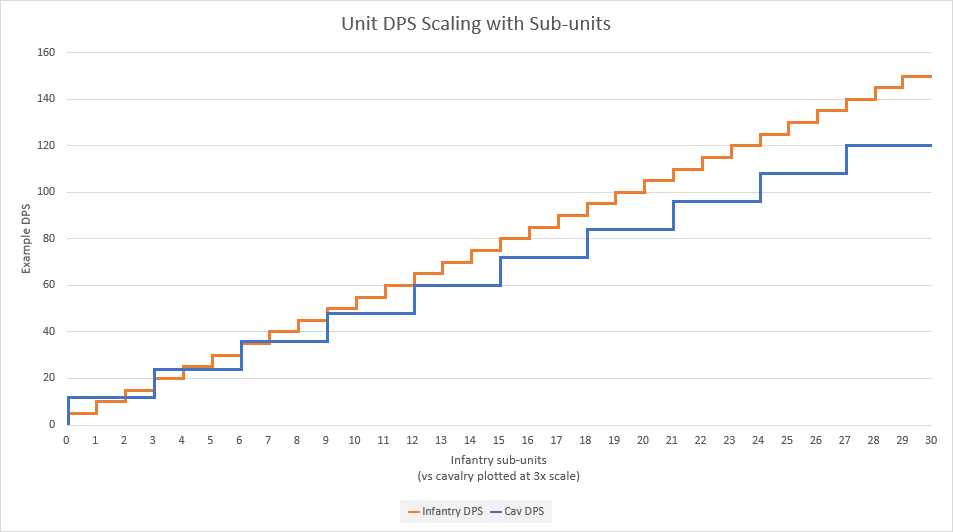
This is effectively a single 30-sub-unit infantry unit against a single 10-sub-unit cavalry unit, but in-game you’re controlling 10 full units on each side. Rather than reading the chart from left to right, it might be more helpful to read it right to left: every time a unit (sub-unit for infantry) dies, that unit’s DPS line goes down.4
If you hone in on the bottom left you can see that when 3 infantry sub-units (i.e., a single infantry unit) are fighting a single cavalry unit, the cavalry unit can potentially cut the DPS output of the infantry squad from 100% to 67%. This would could cause the cavalry unit to spend the majority of the fight dealing more DPS despite starting out with slightly lower DPS compared to the infantry squad. However, as you add more infantry to the one side and cavalry to the other, it becomes more and more difficult for the cav to quickly kick the infantry down below their DPS. By the time you get to a fully-fledged 10v10 it’s simply not possible to accomplish that in in a timely manner, at least in this matchup of imaginary example units.
You can also more easily see how valuable it is in small-scale fights (like 1v1s) to not have the potential DPS penalty of having sub-units, as a half-health cavalry unit will still deal full DPS until its HP reaches zero.
It’s difficult to manually translate real-world DPS onto a graph like this because of effects such as RoN’s focus-fire penalty, so you’ll have to live with just this theory-based example — but I do think it illustrates the point fairly well. While I’ve made the DPS numbers for each unit up, they do very roughly reflect the situation with Musketeers vs Golden Hordes.
How many Golden Hordes does it take to change a lightbulb?
Let’s revert the projectile speed back to its original value and see if adding another couple of Golden Hordes is any better. After all, not only does one Age V ranged cav cost less total resources than Musketeers to begin with, but the Mongols also have their additional 10% discount which goes hand-in-hand with the unit itself.
Here’s the test run three times 10v12:
We can see that our pal non-linear army scaling shows up HUGE here, able to just narrowly win two of the three fights. This is one of the best “real world” examples of this phenomenon that I’ve ever seen, and is why I so strongly try to drive home the idea of avoiding any non-essential losing fights wherever possible. In some cases, even just a couple of extra units can be all it takes to turn a landslide loss into a small victory.
Suspiciously, the second result diverges significantly from both of the other two, so it’s unclear what a median result would look like if the test was run many more times. To remedy that I’ve run the same test another six times “off screen”. In three of those the Musketeers won and in three the Golden Hordes won — but when the Musketeers won, they won by a larger margin (which is also shown to a lesser degree in the screenshots).
When averaging all nine samples, the median result is Golden Hordes winning with 3 remaining GH with an average HP of 3/4 each. The average result of the nine samples is actually the Musketeers winning with perhaps 1-2 half-health Musketeers left. It’s interesting to see how much rng variance factors into the outcome of army-vs-army fights! The next time you lose a fight that you think is even it’s probably still your fault, but there’s a small chance you just got unlucky.
Resource cost comparison
Assuming no other sources of ramping for simplicity,5 here’s the cost comparison:
| Units | Food | Timber | Wealth |
|---|---|---|---|
| 10x Musketeer | 865 | 765 | 0 |
| 10x Carabineer (for reference) | 0 | 765 | 565 |
| 10x Golden Horde (Mongol bonus) | 0 | 705 | 525 |
| 12x Golden Horde (Mongol bonus) | 0 | 934 | 697 |
Food may or may not still more valuable than Timber in Age V, but Wealth probably remains more valuable than either. Given that, 12x Golden Horde does seem to the closest match cost-wise to 10x Musketeers, although it may subjectively be a unit composition that’s a smidge more valuable than the ten Musketeers.
In reality this table doesn’t accurately reflect the unit costs, as building Fusiliers (and remember that you basically must build Fusiliers or their equivalent UU in Age V) will cause both Musketeers and Fusiliers to hit their maximum cost since their costs ramp together. Similarly, if you build a bunch of melee cav (or even just more than ~15 ranged cav), you’re going to cap the costs of those units too.
For Musketeers that capped cost is 157 Food and 135 Timber. For a Mongols player, the capped cost of a Golden Horde is 129 Timber and 86 Wealth, which does start to make them reasonably attractive for large army sizes — particularly since you can reallocate wealth from heavy cav into ranged cav given how (comparatively) weak the heavy cav are during Age V.
Having Monarchy further favors using a larger mix of cavalry units, as even if you pit its discount against the seemingly-similar discount provided by Despotism, Monarchy affects the entire cost of Stable and Auto Plant units. Despotism in contrast only affects the base cost of Barracks units — a significant difference when you consider that ramping costs will make up somewhere in the neighbourhood of half of a unit’s total cost at that point in the game.
We’ve covered quite a bit already, but why stop there? There’s still a lot of other factors that need to be considered.
For fuck’s sake, please flank
Non-infantry units — ranged cavalry in particular — are inherently much better at flanking than infantry are. In real fights between units you should be trying to use units as best as possible, and an easy way to do this is to lighly flank the opposing army to get in a few juicy side shots that come with a +100% damage modifier (translating into well over 200% total net damage because of factors such as armor causing increasing returns as raw damage dealt increases).
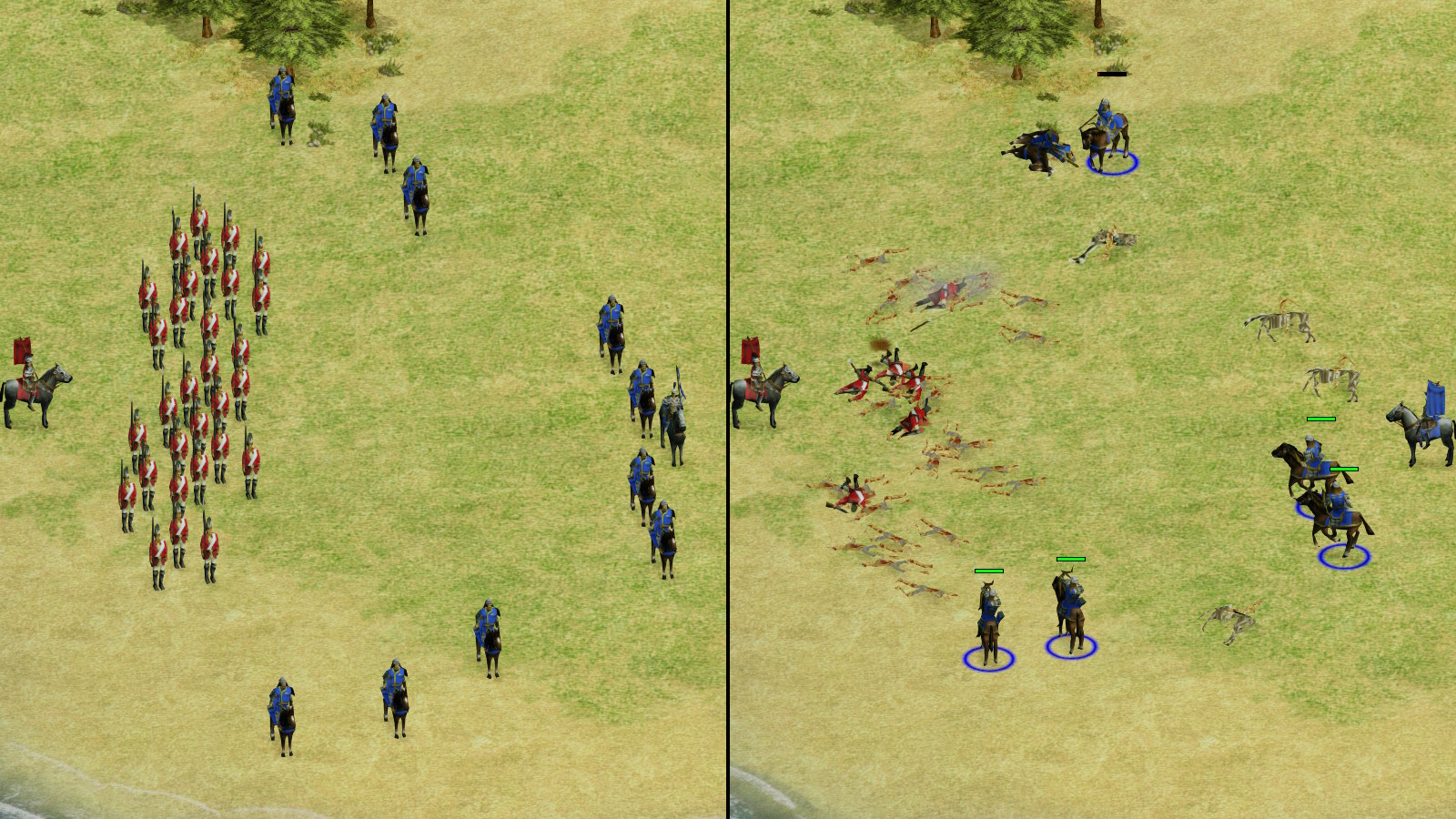
Using what I would call a light flank that doesn’t even encroach around the full 180 degree frontal hemisphere of the Musketeers, Golden Hordes can win handily in a straight 10v10 where they’re being used even vaguely to their full potential. You could do far better than this again with more effort, but “high impact, low effort” is a very good place to start. Note that I only tested this scenario twice (not 10+ times like some of the others), but you get the idea even with a fairly small sample size. The second result was basically the same as what you see above.
This is also a good example of how using a unit lazily makes it appear bad, but putting in some effort is enough to make it perform rather well in the same circumstance. I believe that this is how units should mostly be balanced around: rather than making the unit so strong that it will win a 10v10 when both sides just attack move onto each other, you reward the player that makes use of basic tactical maneuvers.
Matchups against other units
We’ve already covered quite extensively how the Mongol UUs fare against Light and Gunpowder Infantry, so let’s look at how they square up against other units. For the most part this is just a rundown of the matchups that ranged cav have more generally, since the bonus damage modifiers of the Mongol UUs only apply to the units previously covered. Nonetheless, it’s important context for the Mongol UUs to have.
Early on they can do an alright but fairly unremarkable job against Heavy Infantry — in part due to their range advantage. However, not only do HI negate that range advantage in Age V, they actually gain base stats very quickly in comparison to other units.
Here’s the HP/attack scaling for the default units across the six unit categories during the first few ages: (this does of course ignore some other stats, but we only need the broad strokes in this case)
| Unit Type | HP gain per Age | Attack gain per Age |
|---|---|---|
| Light Infantry | 10-15 | 1-2 (2 in CBP) |
| Heavy Infantry | 25 | 2 |
| Foot Archers | 10 | 2 |
| Light Cavalry | 18-22 | 1-2 |
| Heavy Cavalry | 25 | 1 |
| Horse Archers | 15-17 | 2 |
Notice how Heavy Infantry tie for having both the highest HP gain and the highest attack gain. In particular, compare this against the HP scaling of Horse Archers (Mongol UUs included). When applied in-game that means that in head-to-head combat, ranged cav increasingly struggle against HI as the two units are upgraded. Their benefit is instead in the range advantage which they hold for the first few ages. Combined with their ability to fire while moving and it’s still a decent matchup for a player who does some basic micro — so long as you’re not losing that range advantage to e.g. Immortals or Fusiliers.
Fighting Foot Archers is an unmitigated disaster, with a single Golden Horde (V) unable to reliably beat even a single Crossbowmen (III) despite their age advantage.
Moving onto the other cavalry, Light Cavalry is (as you might expect) another unmitigated disaster across all ages. Ranged cav are horrifically, catastrophically bad against light cav. If you repeat the experiment of 10 defenders vs not 10 but 12 Golden Hordes, the median result is that the Hussars win with no casualties. It’s not quite as bad earlier on due to a combination of unit stat scaling (see above table) and lower armor bonuses, but obviously it’s still the strong countermatchup it was intended to be.6
Heavy Cavalry are somewhat less bad, but still a clear losing matchup in a head-to-head fight. In a 2v1 against a single Knight, two Steppe Nomads (+4 armor for both sides) tend to suffer only one casualty with the second Steppe Nomad coming out decently healthy.
So in summary, for the first few ages the combat matchups for ranged cav (inclusive of Mongol UUs) are… not great. It’s very unlikely that it makes sense to use them in a direct-combat role until Age IV at the minimum, but most likely Age V is the only time it can broadly make sense.
Mixed composition army-vs-army combat
If Age V is the best chance for the Mongol UUs, let’s evaluate Age V. They seem to be primarily competing against Musketeers in an army composition, secondarily pushing out some heavy cav as well.
Here’s our example army:
- 12 Musketeers
- 10 Fusiliers
- 8 Cuirassiers (attacking from flank)
And the Mongol army:
- 6 Musketeers
- 10 Fusiliers
- 7 Golden Hordes
- 4 Golden Hordes (attacking from flank)
- 4 Cuirassiers (attacking from flank)
The Mongol army has 3 more total units, but because of their nation power discount and producing less Barracks units at fully-ramped-cost, the overall cost of both armies should be similar. Both armies have +6 armor. To make it abundantly clear that these results reflect official balance, I tested this scenario using T&P Patch 2 (0800), not EE or CBP.
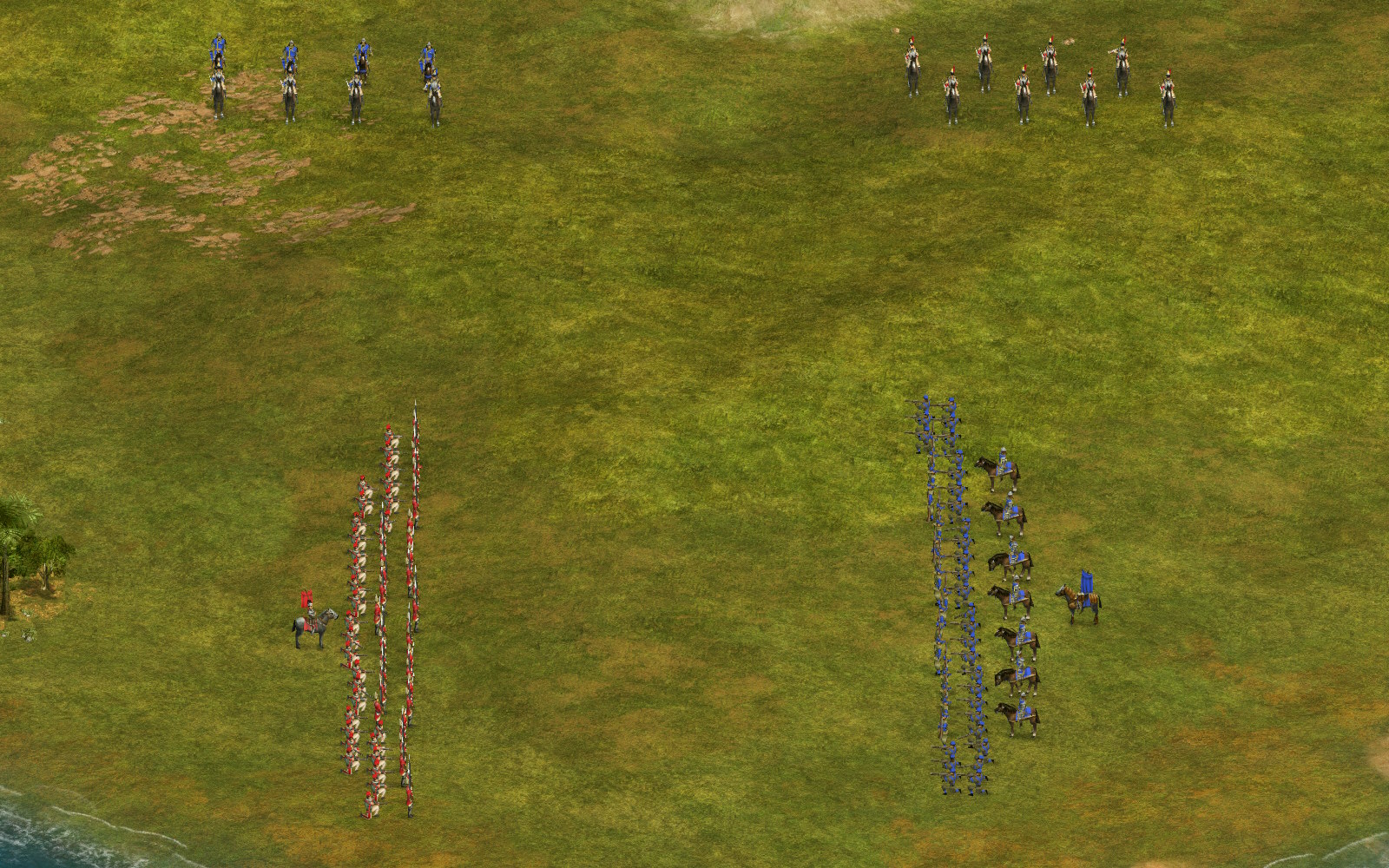
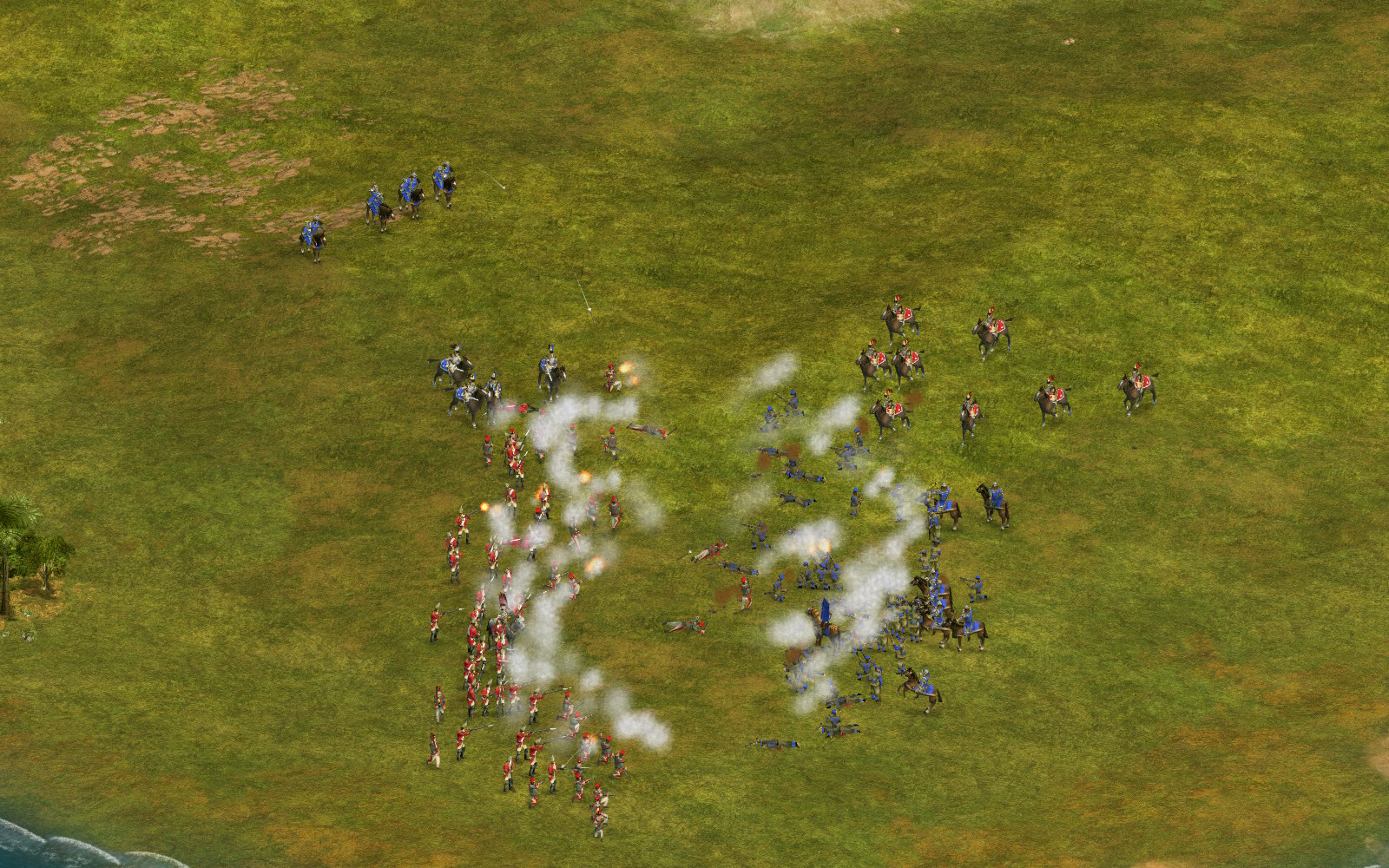
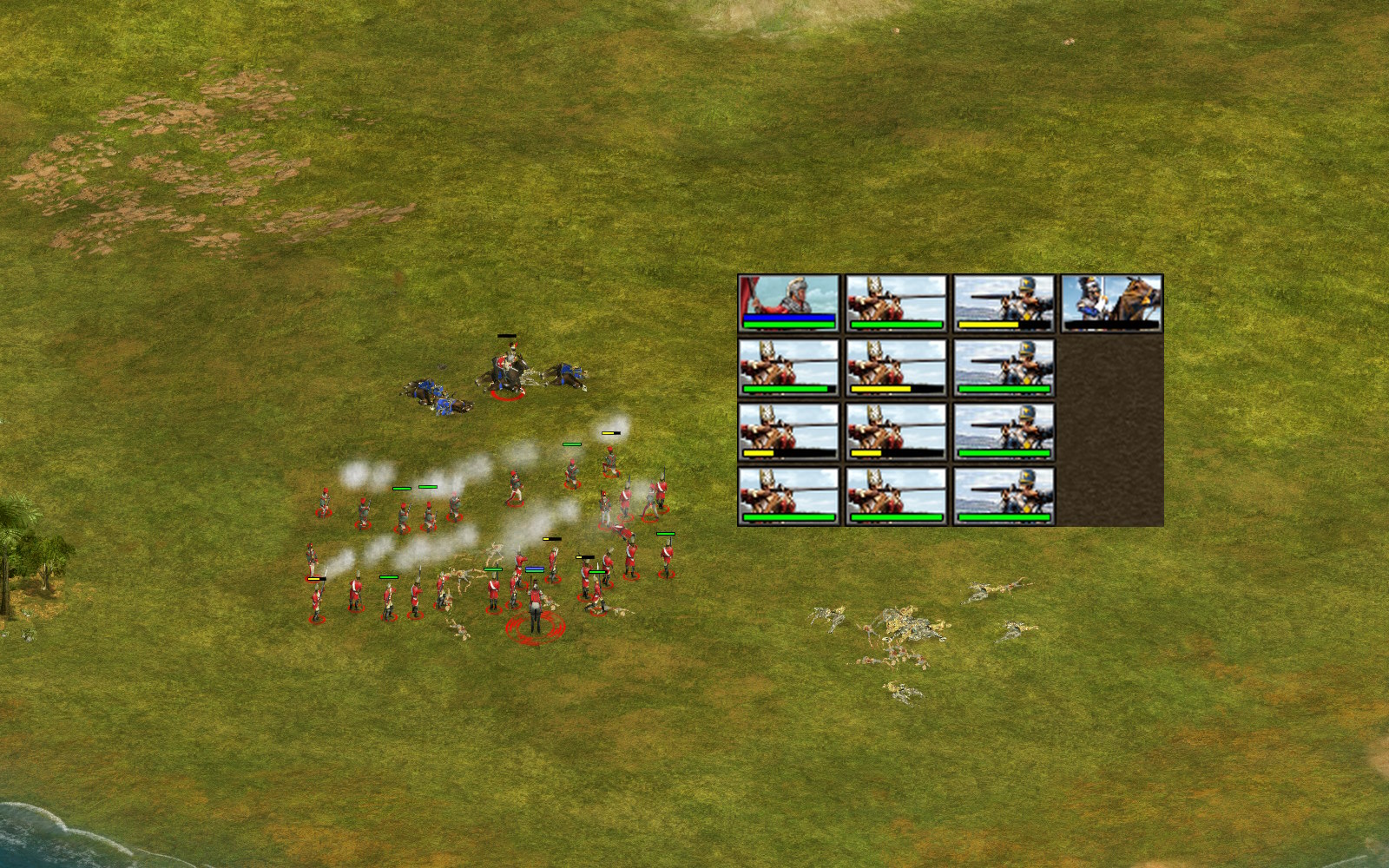
While not a complete landslide, I certainly wouldn’t call this a close result. I’m sure there are small changes that could be made to both tactics and composition that would improve the result, but I believe this is a sufficiently good representation that I’m just going to call it a loss. Even if all seven primary-army Golden Hordes flanked on the southern side (independently of the existing flank on the northern side), that’s not enough to hand-wave away a result with this margin of failure.
I believe the problem stems from multiple issues:
- Although Mongol UUs are decent against Musketeers, they’re not good against Fusiliers. This makes them a pretty bad replacement for Musketeers in an army.
- Since an army with less Musketeers is worse against Fusiliers, it makes it much more challenging to use Cuirassiers effectively. In my test I reflected this knowledge by substituting four of them with Golden Hordes.
- However, Cuirassiers are substantially better against Musketeers than Golden Hordes are, so you get more mileage out of using Cuirassiers vs Musketeers than you do with Golden Hordes (but only if the area isn’t protected by Fusiliers).
If you tried to replace Fusiliers instead of either Musketeers or Cuirassiers, I imagine the results would be even worse without enough firepower to keep flanking Cuirassiers at bay, so that’s not a viable option either.
In a different timeline this would be where the article wraps up and I tell you that I was Right All Along™: Mongol UUs do not fit well into a standard army composition and despite their substantially better performance against Light and Gunpowder Infantry, they’re still worse in an army than any of the units they could be replacing.
Unfortunately for my spare time, Rise of Nations has an expansion.
Long live the King
In every test I’ve run so far, we’ve been using ordinary Generals. In reality, almost all Mongols players would actually be using The Monarch. So, let’s give this one last shot. For good measure we’ll get the Mongols army one more Golden Horde as well, and we’ll also swap two Fusiliers for Musketeers (since enemy Fusiliers seemed to be one of the biggest problems last time). If the UUs can’t win in balanced-composition army-vs-army combat here, they can’t win balanced-composition army-vs-army combat anywhere else either.
First — just to isolate what causes what — here’s the fight with those changes except for The Monarch:
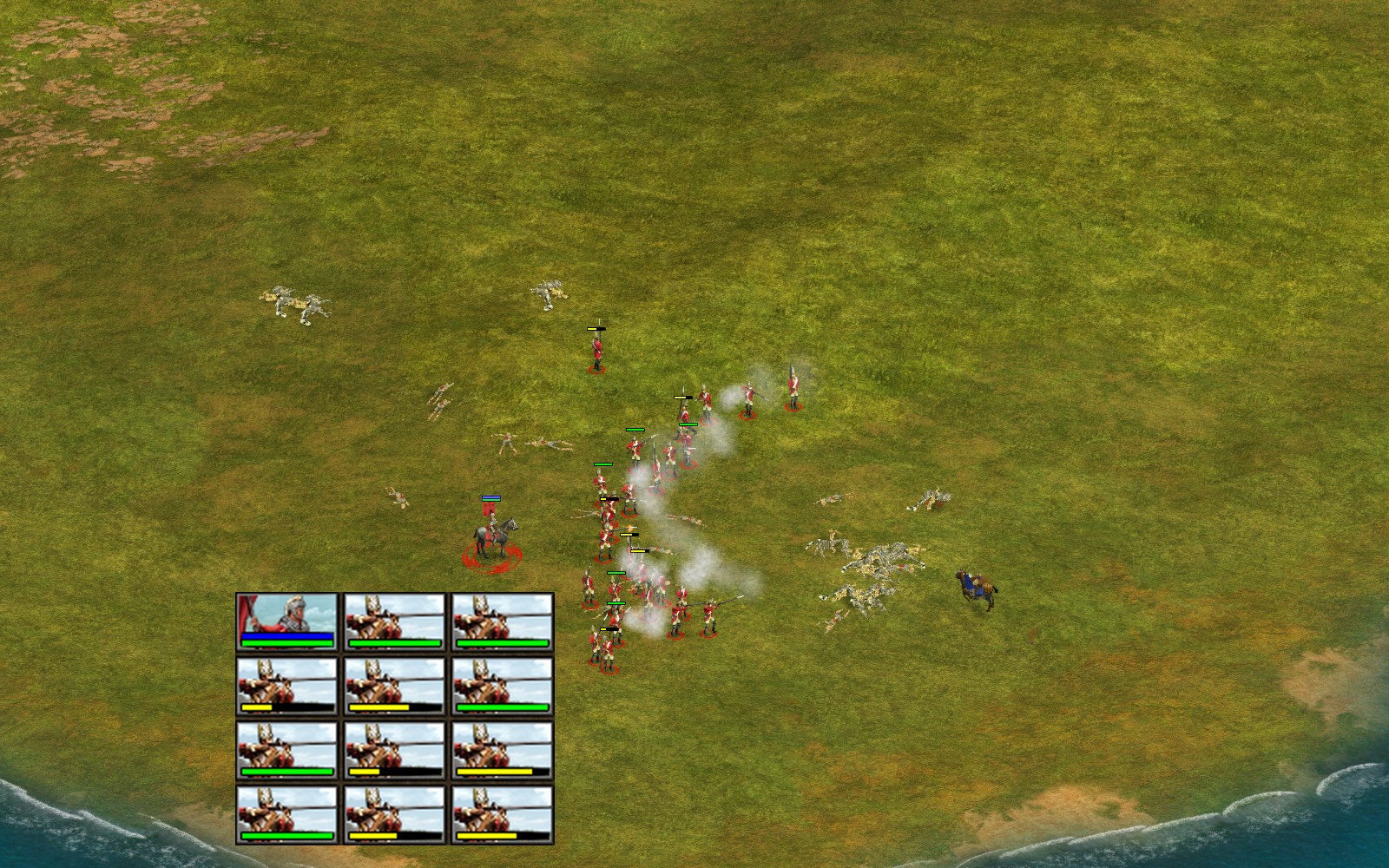
As you can see it’s still a clear win. Red’s Fusiliers are taken out of the picture a little earlier as hoped, but I will mention that the last of the Fusiliers were only killed in the moments leading up to the screenshot; both of the last two Red units to die were Fusiliers.
Alright, now let’s repeat but give both sides their Monarch:

For the first time in army-vs-army combat: a clear win for the Mongols side. I ran this test twice and both the flow and overall outcome of the fight very similar both times,7 so this seems like a fairly stable result for these inputs. I’m not entirely sure if these armies actually cost the same anymore, but they should at least be close enough to say that the Mongol UUs are at least adequate with the Monarch’s support.
You might think that this is the vindication for all those people that use the Mongol UUs in army combat. “I knew it!’ they shout, “despite not knowing about how damage modifiers work, I figured it out through playing the game, the way you’re supposed to you nerd.”
However, to achieve this result we’ve spoon-fed the Mongol army the best case scenario, adapting the forces supporting the Golden Horde to get what seems to be the best mix of Musketeers and Fusiliers to face up against the static composition of the opposing army. In a real game, that other player would be free to tilt towards additional melee cav of their own in order to claim victory back despite the Mongol player’s best efforts. Remember, Golden Hordes are a train wreck against light cav and still bad against heavy cav. Replacing a few infantry with either of the two melee cav and sending them into the back on a slight delay (to avoid Fusiliers) would be highly advantageous but we simply haven’t modeled it.
The really interesting thing I want to point out however, is about the Mongol UUs interaction between these units and The Monarch: the Mongol UUs were never balanced around supposedly needing The Monarch to make them usable for this role.
How do I know this? The Mongol UUs were released with vanilla RoN back in 2003.8
The Monarch was released with Thrones & Patriots in 2004.
In other words, the Mongol UUs — as they were originally designed — are simply not that great for army-vs-army combat despite their bonuses, and were not designed to have The Monarch there to salvage that outcome. With that insight out in the wild for you to ponder, let’s keep testing if there’s a scenario where they’re genuinely strong in army combat.
The premise of using these UUs in army combat is that they must replace another unit: Musketeers, Fusiliers, or Cuirassiers. This means the question isn’t “can Golden Hordes be good in army combat?”, it’s actually “can Golden Hordes be better than other units in army combat?”. Let’s see what happens if a Mongols player instead funnels their nation power discounts into building some extra Cuirassiers instead of Golden Horde. That might still represent an advantage in combat over other nations without a convenient discount on their cavalry.
As a reminder the non-Mongol army is 12 Musketeers and 10 Fusiliers, with 8 Cuirassiers on the flank.
Previous Mongol army:
- 8x Musketeers
- 8x Fusiliers
- 8x Golden Hordes
- 4x Golden Hordes (attacking from flank)
- 4x Cuirassiers (attacking from flank)
Revised Mongol army:
- 10x Musketeers
- 8x Fusiliers
- 12x Cuirassiers (attacking from the flank)
Cuirassiers are more expensive than Golden Hordes, so despite being a numerical downgrade, cost-wise this is roughly fair — particularly given the extra 2 Musketeers also thrown in there(!).9
So the answer based on this testing looks like yes! The boost from The Monarch makes Golden Horde adequately competent — seemingly enough to at least out-perform a Cuirassier-heavy composition as shown by the failure of that composition above. This was a single-run test so there’ll be a degree of variance, but based on how I watched it play out, I do think it’s close to a typical result for the given unit compositions.
Now let’s run another test with the Mongol UU army again — but this time the defender sees the Mongols player is using their UUs and swaps 2 Musketeers for 3 Hussars in their composition. Hussars are cheaper than Musketeers in their own right, but with the help of Monarchy this 2-for-3 is very close to an equivalent-cost trade.
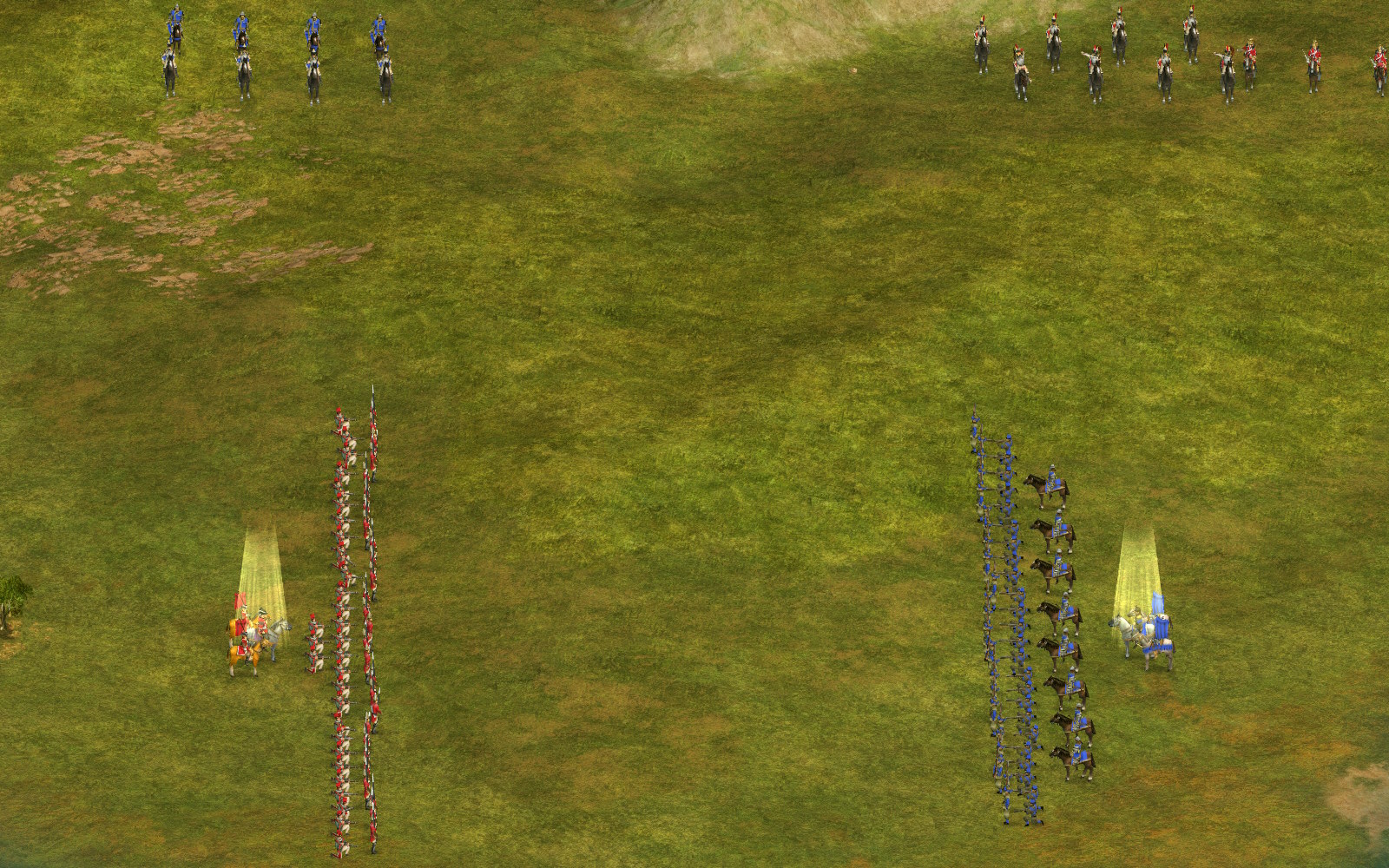
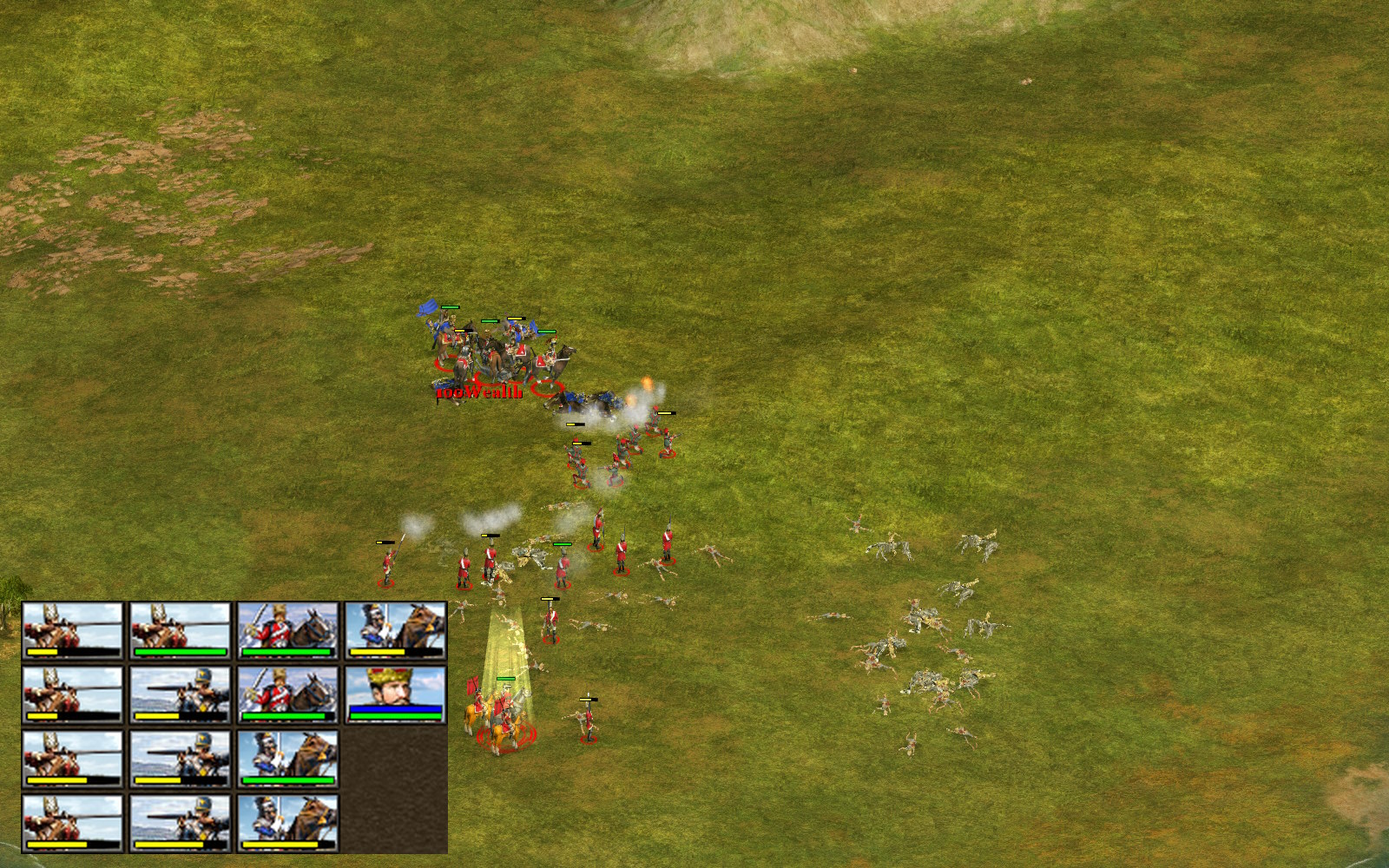
This shows a comparatively huge win for Red. It’s actually the most surviving units out of any of the screenshots in this article so far — and the units are averaging well over half health as well.
It’s especially interesting that so many melee cav survived. Typically these and Fusiliers die first, then the backline DPS of both sides (namely Musketeers) duke it out. Instead we see that reinforcing with those extra 3 Hussars was hugely impactful for shutting down Blue’s Golden Hordes. Not only are the Hussars highly effective at killing them, but having more cav getting up in their face means many of the Golden Hordes end up auto-targeting these cav instead of the Musketeers on the other end of the fight. That obviously doesn’t make use of the bonus damage from the UUs, whilst the light cav are benefitting from the their own +2 armor bonus supplied by The Monarch.
So whilst against a typical Age V army composition of Musketeers / Fusiliers and Cuirassiers it is correct for a Mongols player to build some UUs against it — conditional on having Monarchy researched and The Monarch in the same army as the Golden Hordes — it also exposes them to more pronounced counterplay. While the Musketeers which they displace are bad against melee cav for example, they’re not catastrophically bad.
To make sure this wasn’t a fluke I ran this one a second time to be sure and the result was even worse for the Mongols player, with an additional two Red units surviving and the average health of their units being even higher.
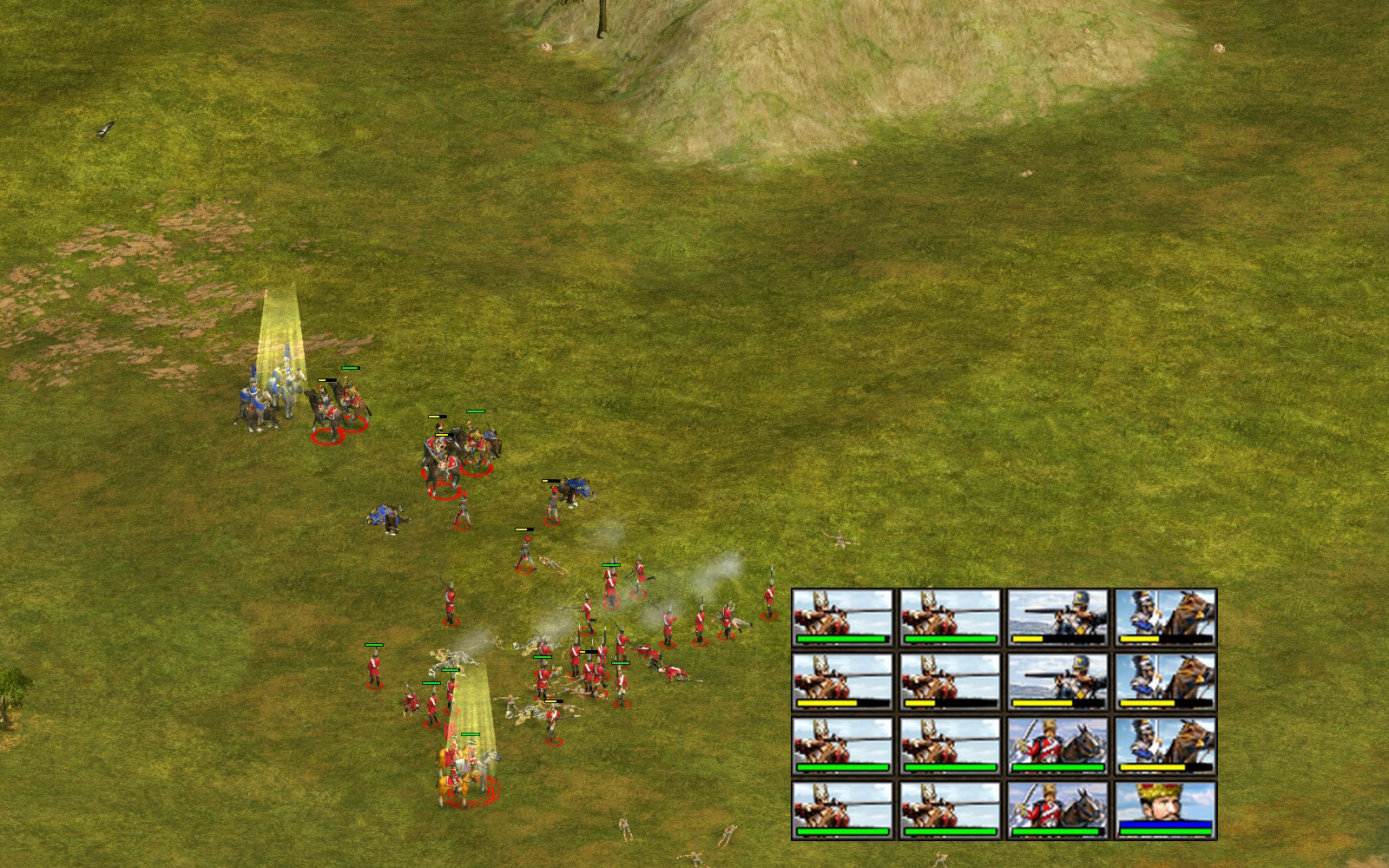
One quirk I did notice during the re-test is that while Blue’s Monarch is always in range for the flanking Cuirassiers, sometimes the flanking Golden Hordes take a while to get into range unless The Monarch is manually moved (which in these tests I’ve avoided until towards the end of the fight). I do run these mid-age tests with Forage enabled for both sides, but some players will also be running Supply given that it’s Age V. In any case, four units aren’t going to make or break a fight by getting +2 attack10 with a result this lopsided.
One could certainly argue that we could go further into counterplay and consequent counter-counterplay reactions:
- Red builds standard Age V composition
- Blue Mongols responds by swapping in some Golden Hordes
- Red responds by swapping a couple of Musketeers for Hussars
- Blue Mongols responds by swapping some extra Fusiliers in
- Red responds by either getting more Musketeers or simply holding back melee cav longer until more Fusiliers are dead
- Ad infinitum.
Based on just the above, it seems fair to say that in the end it’s likely the player who plays better strategically (e.g. modifying army composition) and tactically (e.g., hitting enemy flanks) will ultimately win, which may or may not be the Mongols player. However, there’s an important case we haven’t tested for the Mongols player yet: replacing all Musketeers and all Cuirassiers with Monarch-boosted Golden Hordes, and keeping some Fusiliers around to fend off melee cav.
You see, once they’re Monarch-boosted, Golden Hordes do make viable replacements (per-cost) for Musketeers and Cuirassiers, as they now work fairly well against both Fusiliers and Musketeers, which are what those two units are respectively countering.
Thanks to the stacking cost reductions on top of an already-cheaper base cost, swapping Musketeers for Golden Hordes is a rather lucrative trade once you factor in ramping costs from other sources. Fusiliers would normally be ramping the cost of Musketeers (or vice versa), but if skipping Musketeers altogether we get to keep ramping costs to less extreme levels.
The cost of 10 ramped Musketeers is roughly equivalent to 14 Golden Hordes, give or take. The exact equivalence will depend on exactly how many units of all types you have.
Cuirassiers are also more expensive than Golden Hordes, but it should be noted that the non-Mongols player would actually be avoiding excessive ramping costs here, as in Age V there’s typically little reason to go beyond a moderate amount of cav on the field at once. However, looking at the ramping numbers a conversion of 4:5 looks about right. Overall resource cost is closer to 4:6 but remember that we’re pushing our Wealth unusually hard for Age V by relying on a unit that requires Wealth more than is typical.
Since we need to protect our precious metallic equestrians, a couple of extra Fusiliers seems in order, and we’ll ballpark the trade-in value at around 3:2.
That leaves us with a total of:
- 10 Fusiliers
- 25 Golden Hordes
Correctly using this composition will require slightly more effort than attack-moving the entire force in. At the bare minimum, the Fusiliers need to be placed BEHIND the Golden Hordes just as if this was a Musketeers + Fusiliers formation. If they get in front they’ll get cut down by enemy Musketeers and there’s nothing stopping Hussars from trampling over the Mongolian dream.
Let’s assume that the opponent has at least an inkling of what’s going on: they don’t change their infantry composition (they’re still scared you might have some Cuirassiers up your sleeve), but they do swap their Cuirassiers to Hussars.
If the Mongols player uses default formation (shown below), their Fusiliers get whacked and Red’s Hussars can move in to safely annihilate the more numerous Golden Hordes. It’s difficult to understate just how bad ranged cav are against light cav at this point in the game.
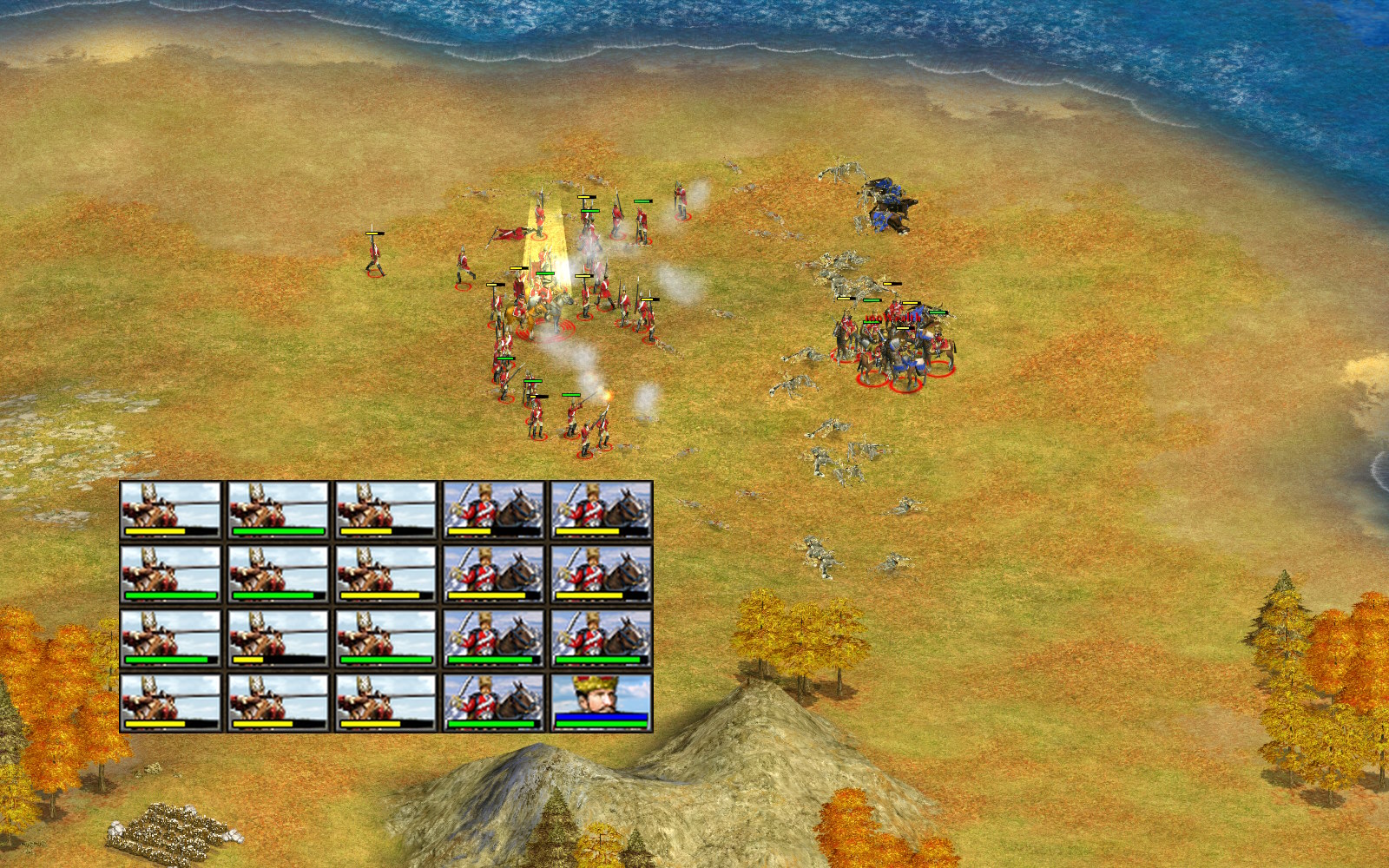
So let’s do the same setup but this time we hold the Fusiliers in reserve, similarly to what we would be doing if using a typical Musketeers + Fusiliers primary army composition.
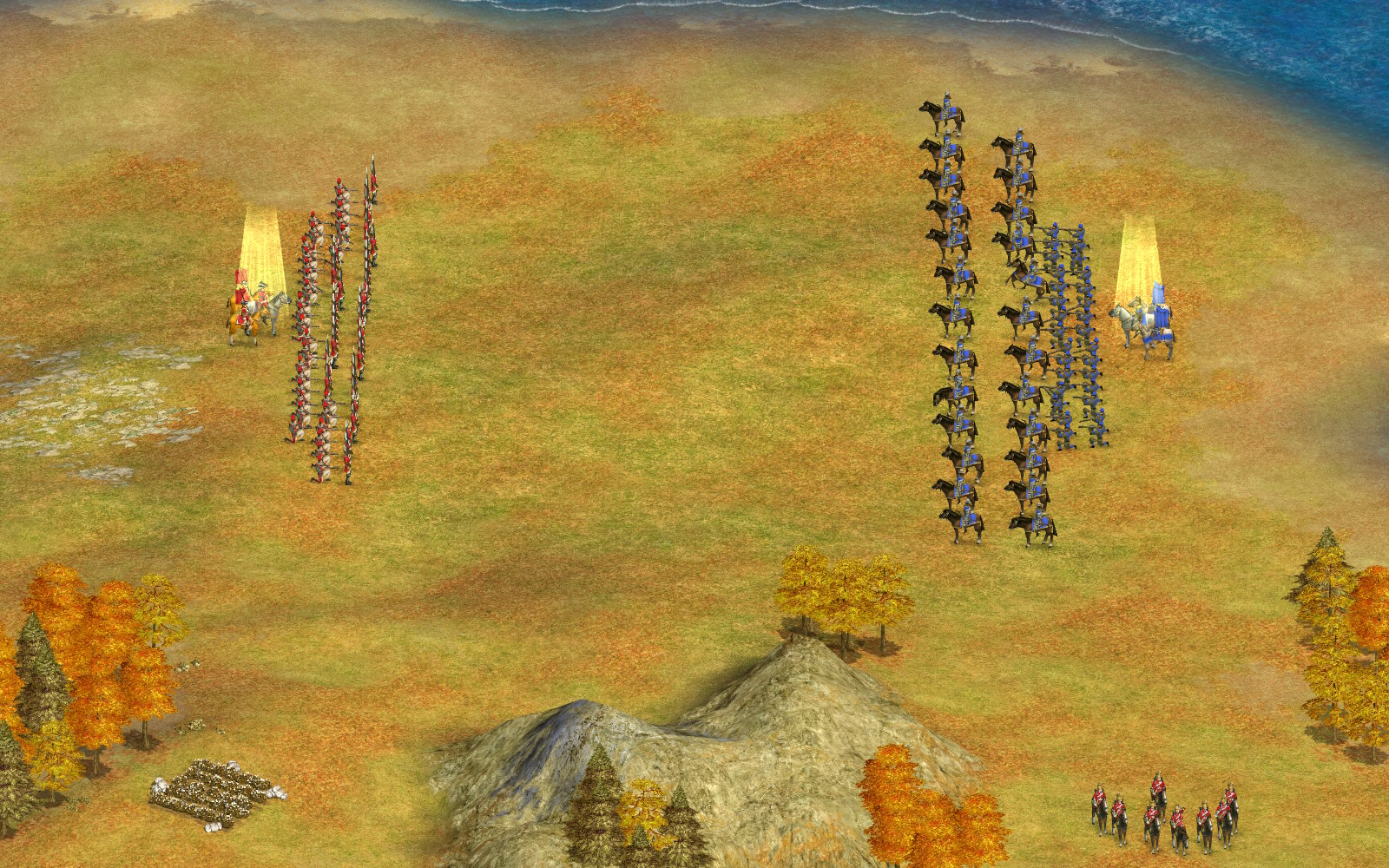
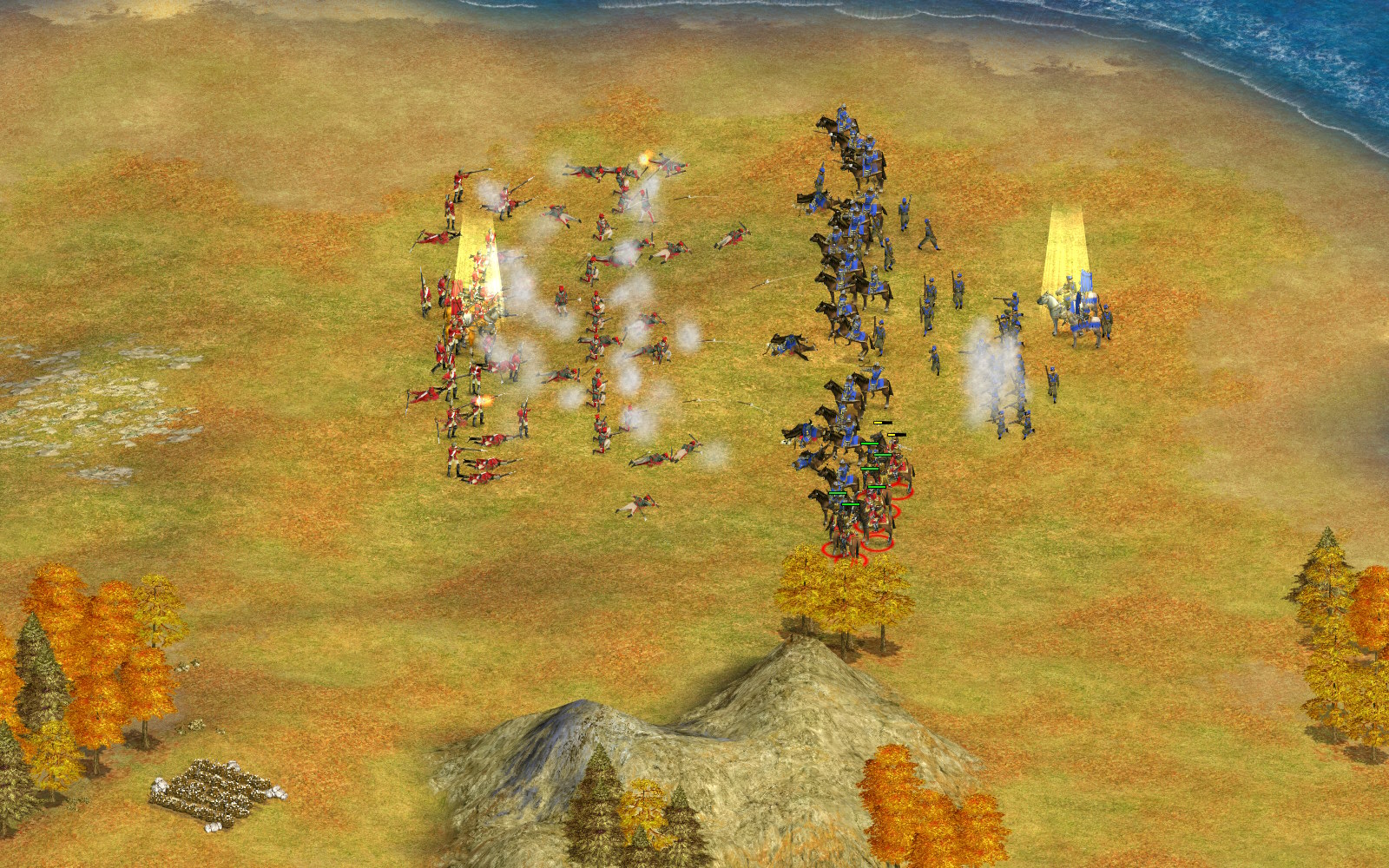

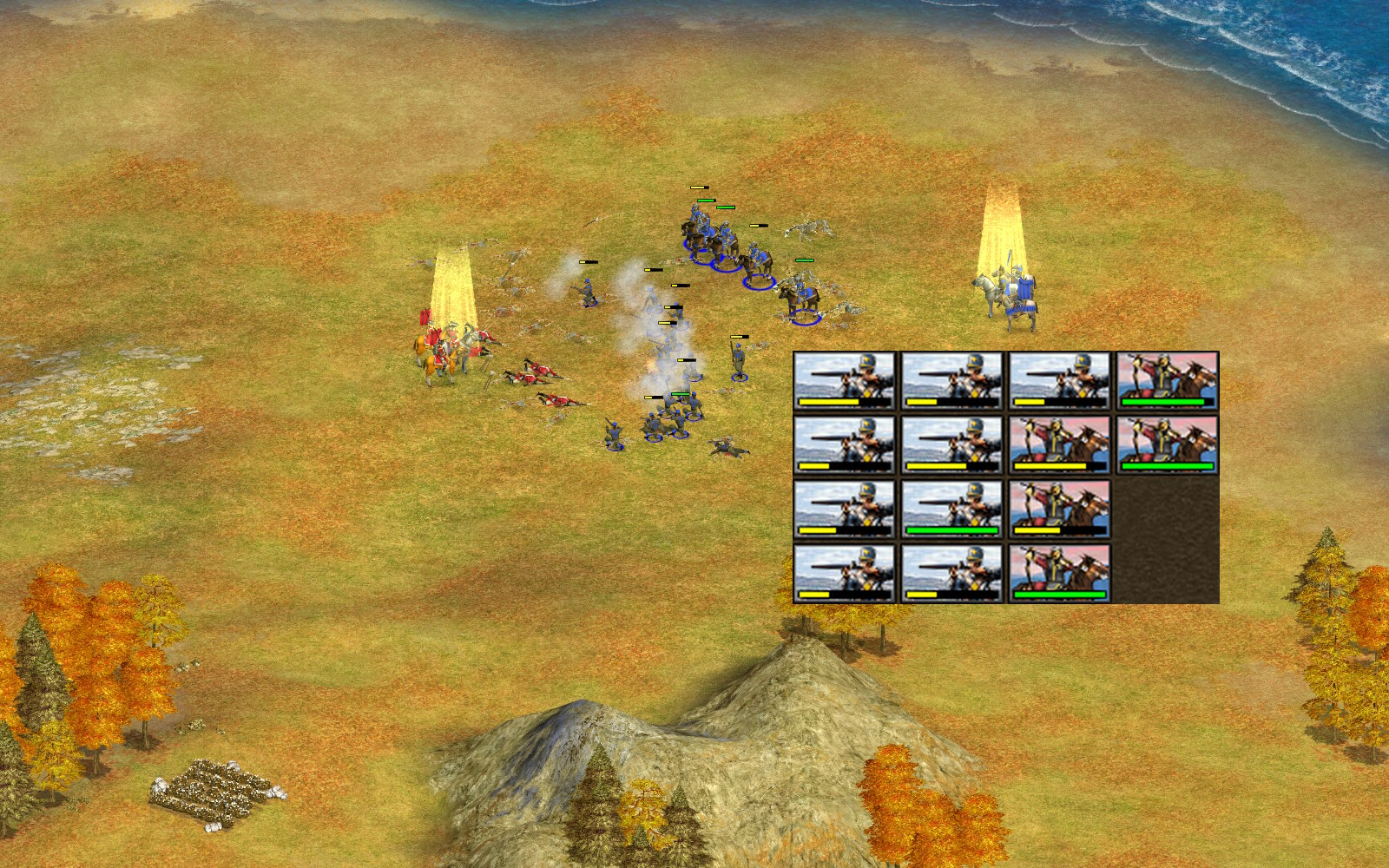
A clear victory for the Mongols player, although you can see that sending the Fusiliers in at the end leaves them in pretty rough shape. Nonetheless this was a result achieved even without use of flanking. And given how strong flanking is (particularly with ranged cav), that’s quite an accomplishment.
In the second screenshot you can see that the Fusiliers are also modeled to sit slightly further from the action (for their safety). If using this composition you could repel melee cav slightly better than shown by moving them up slightly.
How to counter an army with no compositional weakness
The thing about the Golden Hordes + Fusiliers composition is that there is simply no compositional counter to it. Fusiliers soundly wipe melee cav up and Monarch-boosted Golden Hordes can take care of both infantry types. Even if you try to send in ranged cav of your own, Golden Hordes attack ~20% more often (increasing their DPS) and they’re cheaper to boot.
So we’ll say that this composition has fight control. This will make them the aggressor, and the opposing non-Mongols player will end up as the defender. In this scenario there is one more tool we can turn to that might be enough to provide counterplay to the Mongolian hordes: our old friend Entrench.
Now, we’re going to have to make a compositional change to have any hope of making this work, as Musketeers are the only unit that have the range to hit back at Golden Hordes while remaining entrenched. We either drop Fusiliers and hope the Mongols player tunnels on ranged cav (forgetting melee cav), or drop flanking cav. The latter is a much safer play because countering this option gives the Mongols player more-of-the-same (building more Golden Hordes in response to there being less Hussars) which we might be able to beat. If we instead drop the Fusiliers, the Mongols player can throw in Cuirassiers and we’re definitely toast. It might still be okay to drop a couple of the Fusiliers though, so let’s do that to maximise the odds of at least holding out against the Golden Hordes.
Here’s a composition that swaps six of the eight Hussars to build another four Musketeers, and then two Fusiliers for another two Musketeers:
- 18x Musketeers
- 8x Fusiliers
- 2x Hussars (attacking from flank)
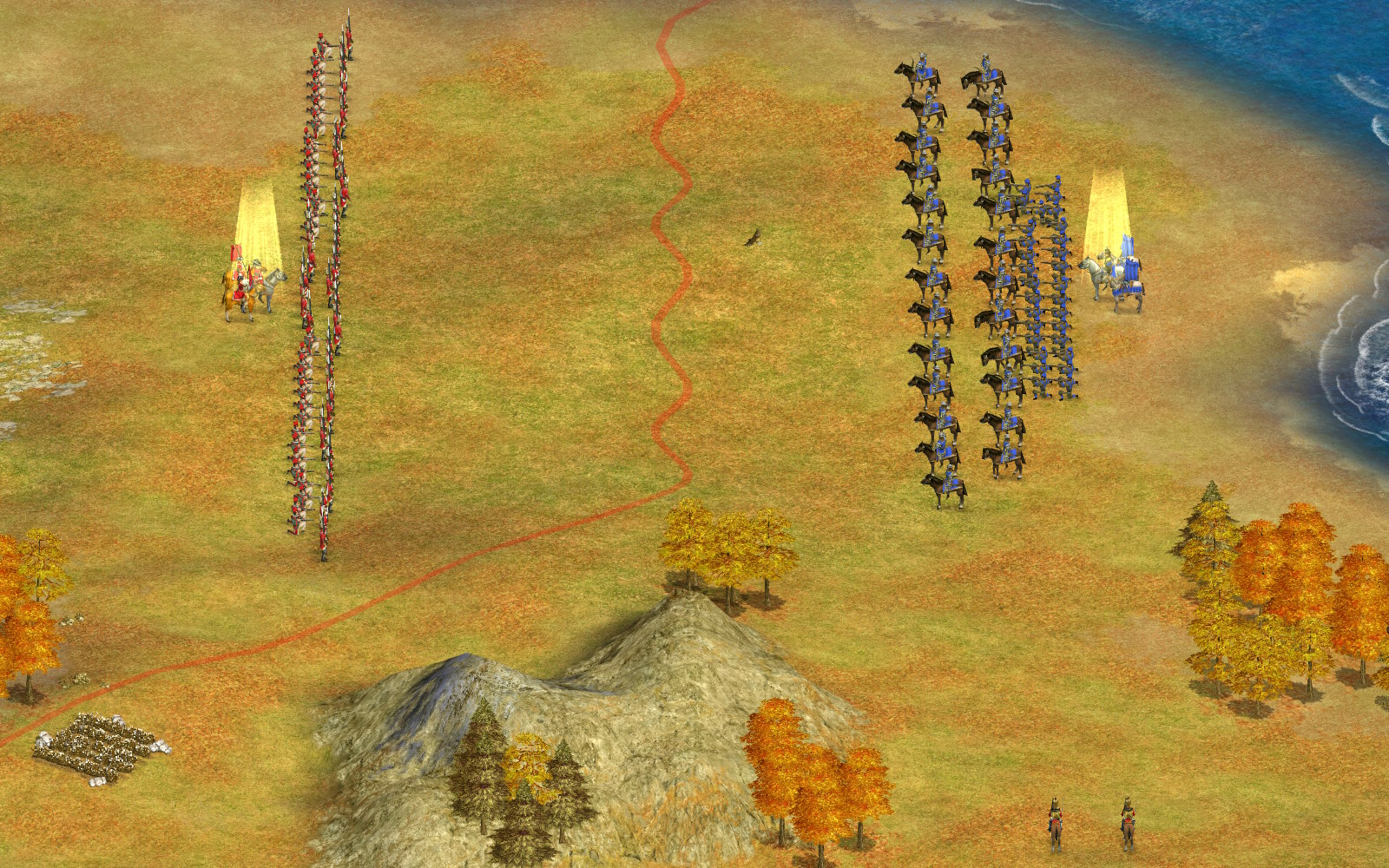
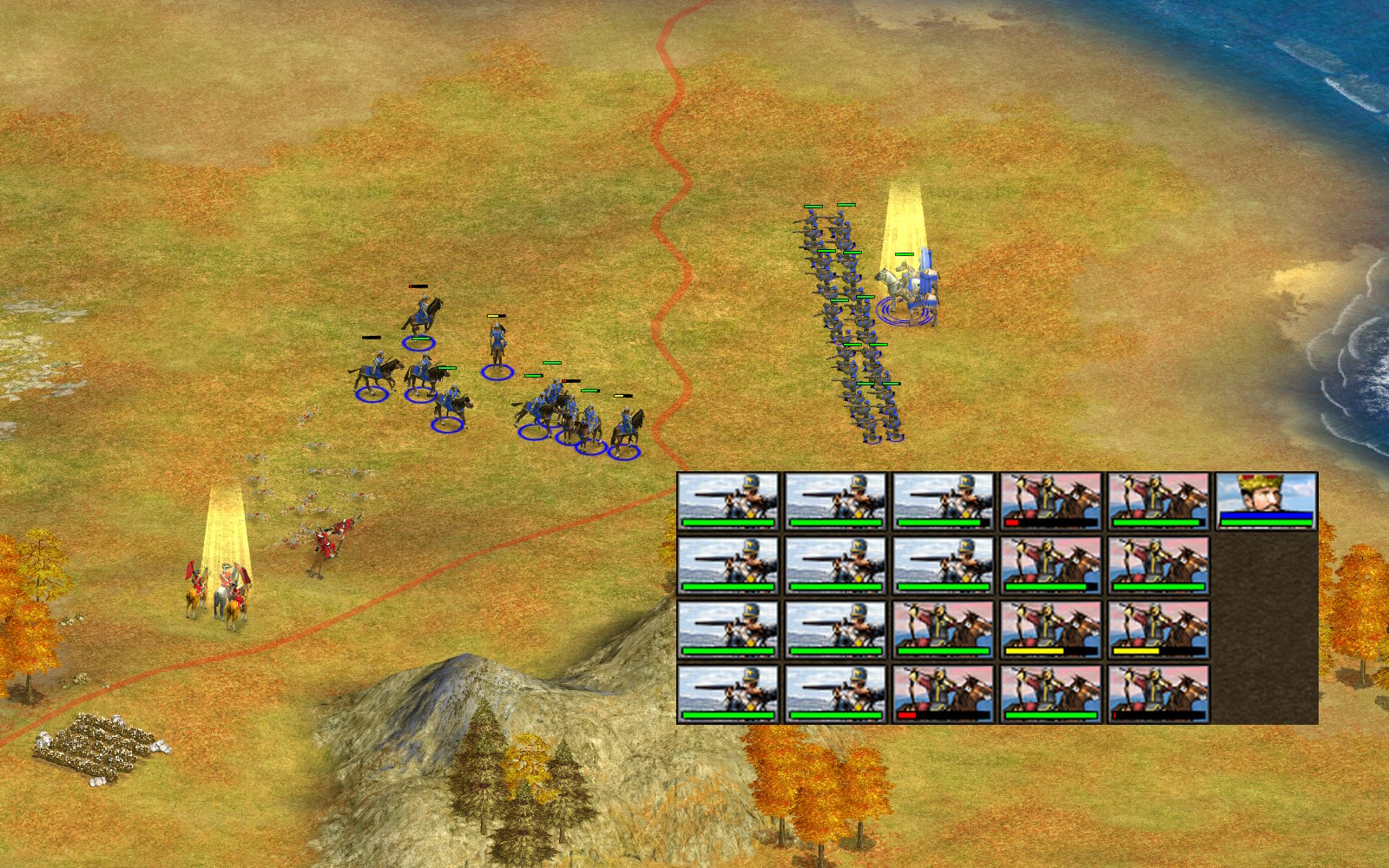
That’s a rough result for Red. Although you should probably avoid doing this in a real game, let’s see what happens if we jettison all of the Fusiliers and try to instead make do with a composition of 25 Musketeers and 2 Hussars.
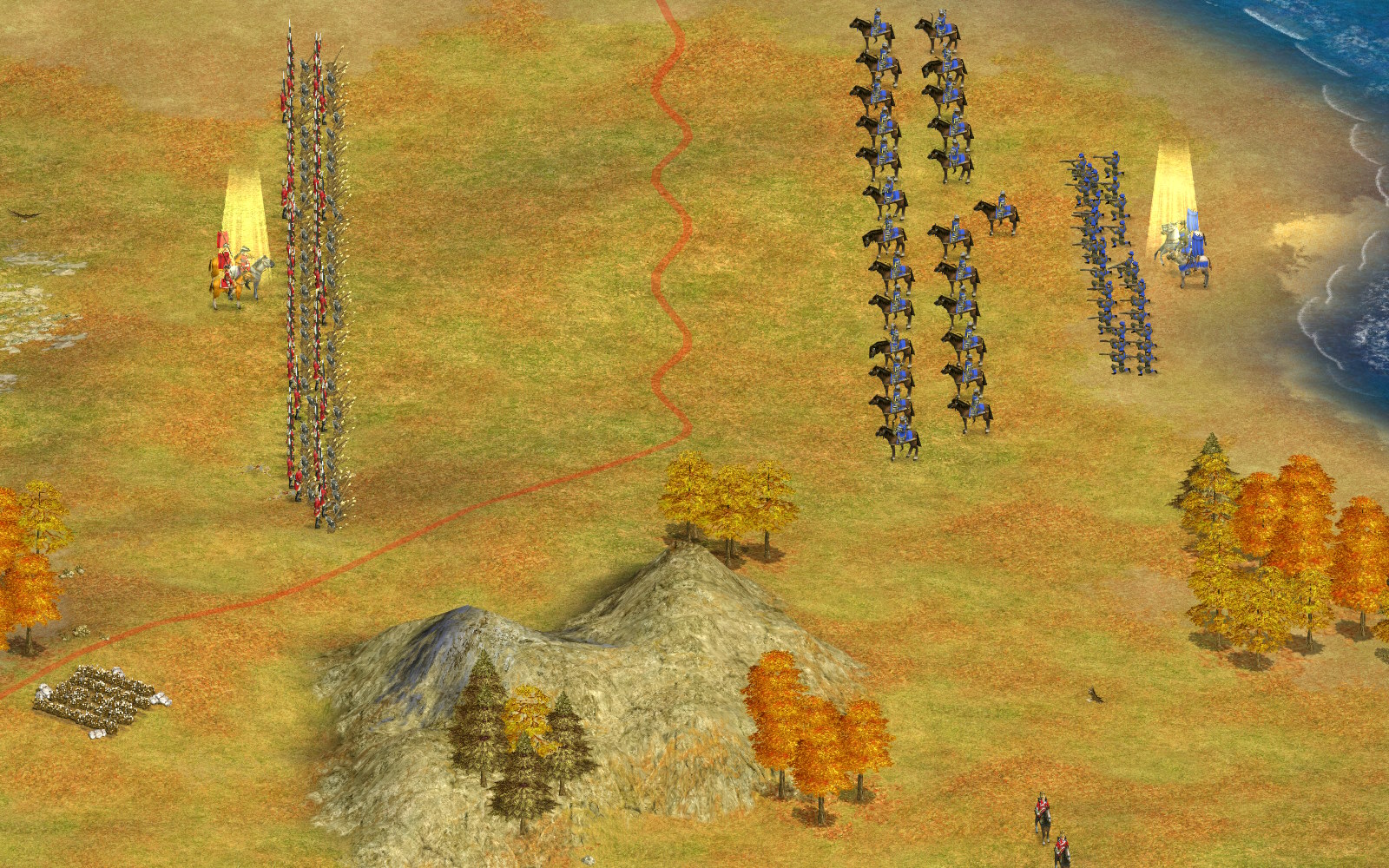
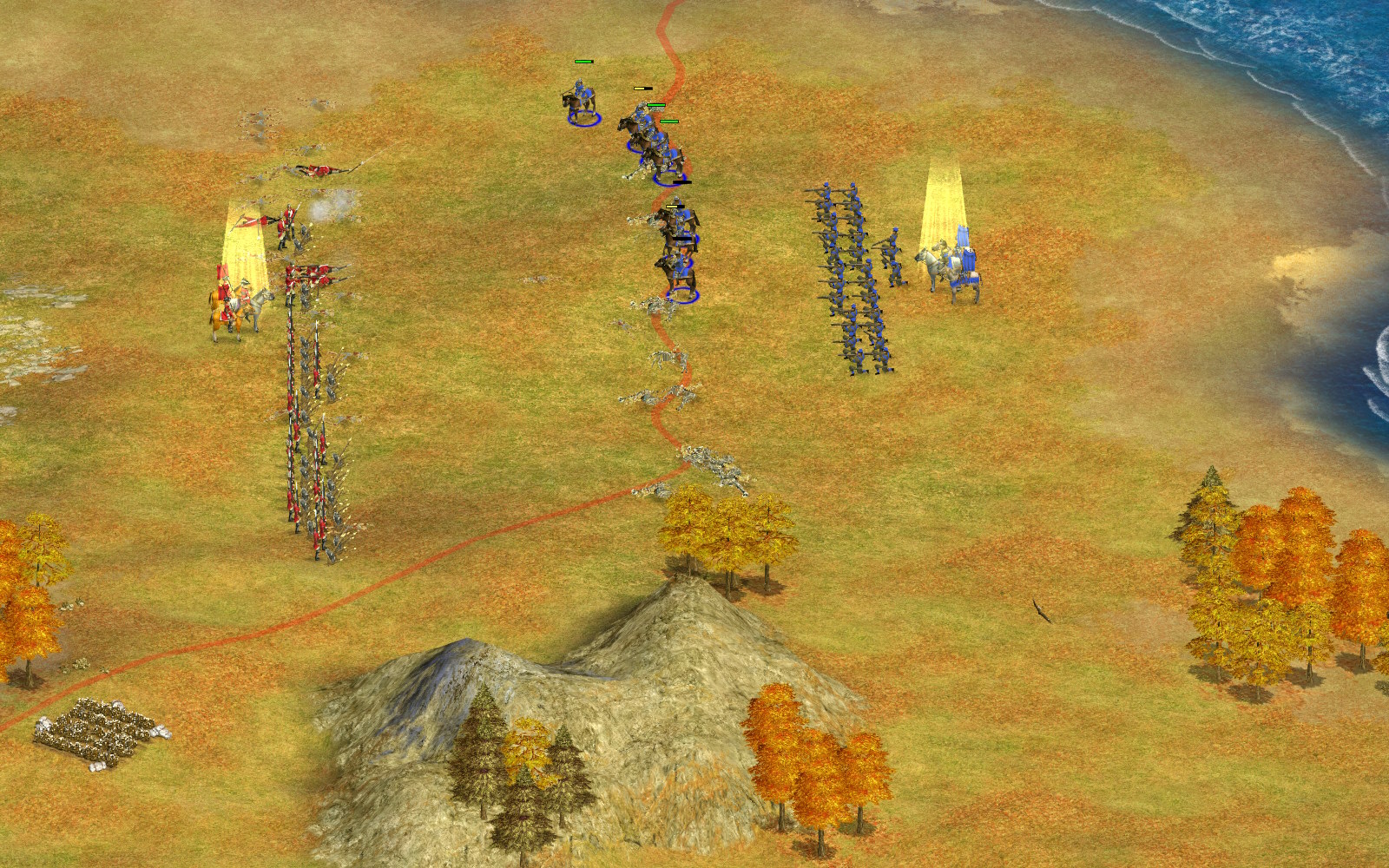
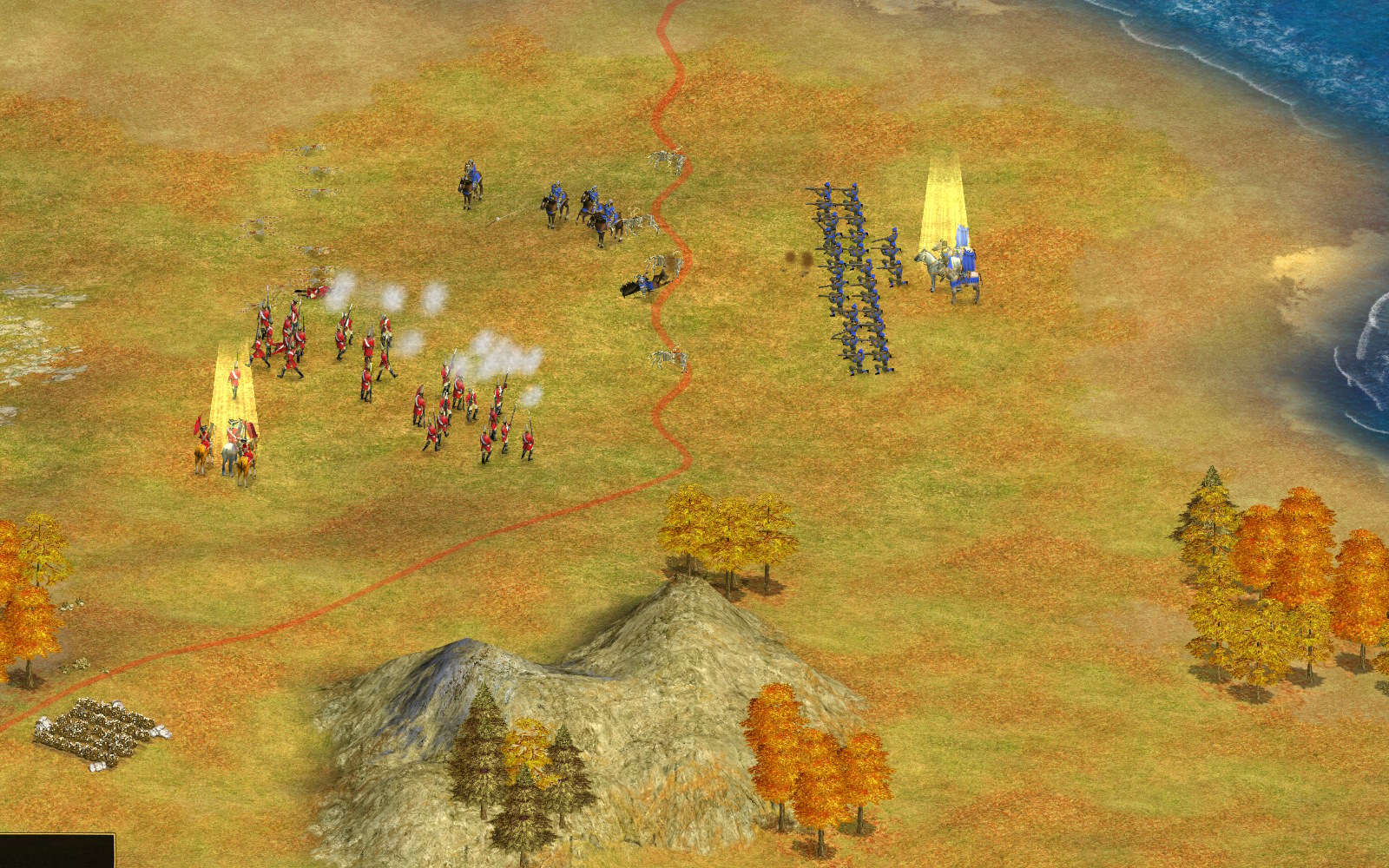
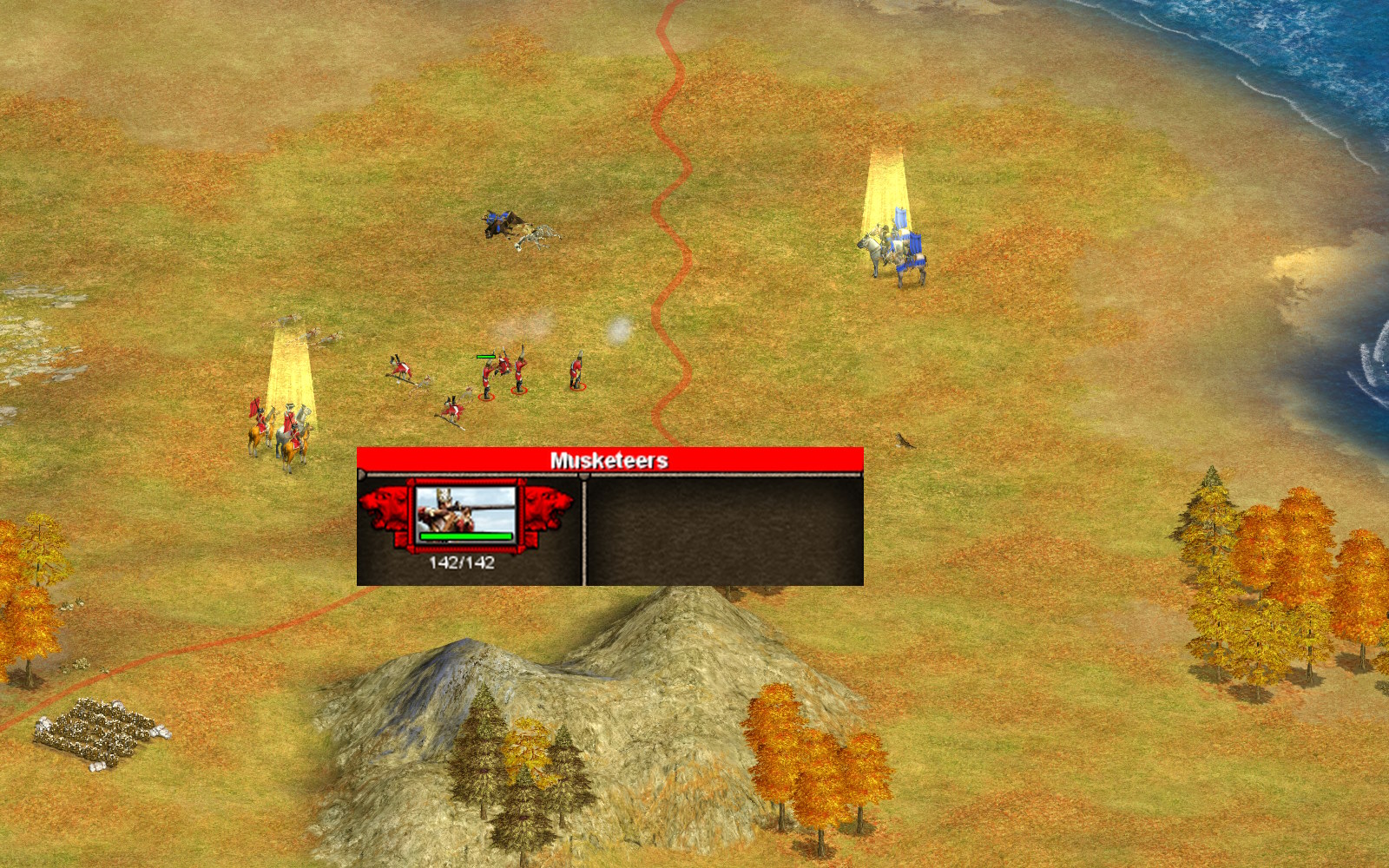
The last screenshot implies a narrow victory, but I would consider this to still be an overall win for the Mongols player. If they did anything in this list:
- Flank during combat
- Focus on one side the entrenched formation only
- Make melee cav
Red loses, and badly. I don’t think there are any other strategic or tactical options for Red left other than try to hold for one age and tech up to Light Tanks to deal with the issue. While doing that will certainly be effective if they can hold out for that long (with the Mongols player ending up with a pile of Armored Cars trying to fight tanks), it’s unlikely that they can given that they’ll lose all army combat by default.
They could try to play around the Mongolian deathball of doom, but if your capital is being sieged then there’s not exactly anywhere else you can deploy troops except at that capital.
To use Brian Reynolds’ terminology, spamming Mongol UUs in Age V appears to be a degenerate strategy. If official balance patches continued long enough for players to make wide use of it then it probably would’ve been patched out. BHG showed a willingness to nerf — and in my opinion sometimes over-nerf — elements of dominant strategies:
- All Mayan nation powers used to be roughly twice as powerful, and their Timber discount used to also apply to military buildings.
- Helicopters used to deal 50% more damage against tanks.
- Iroquois scouts used to have double LOS during the early game, their Barracks units used to have double the HP bonus, and their Heavy Infantry used to have a much higher movement speed bonus.
- Nubian merchants and caravans used to have a 50% cost reduction instead of their current 10%.
That leads us nicely into talking about what this all means in the community patch, which is the main reason I went to the trouble of all this testing and writing.
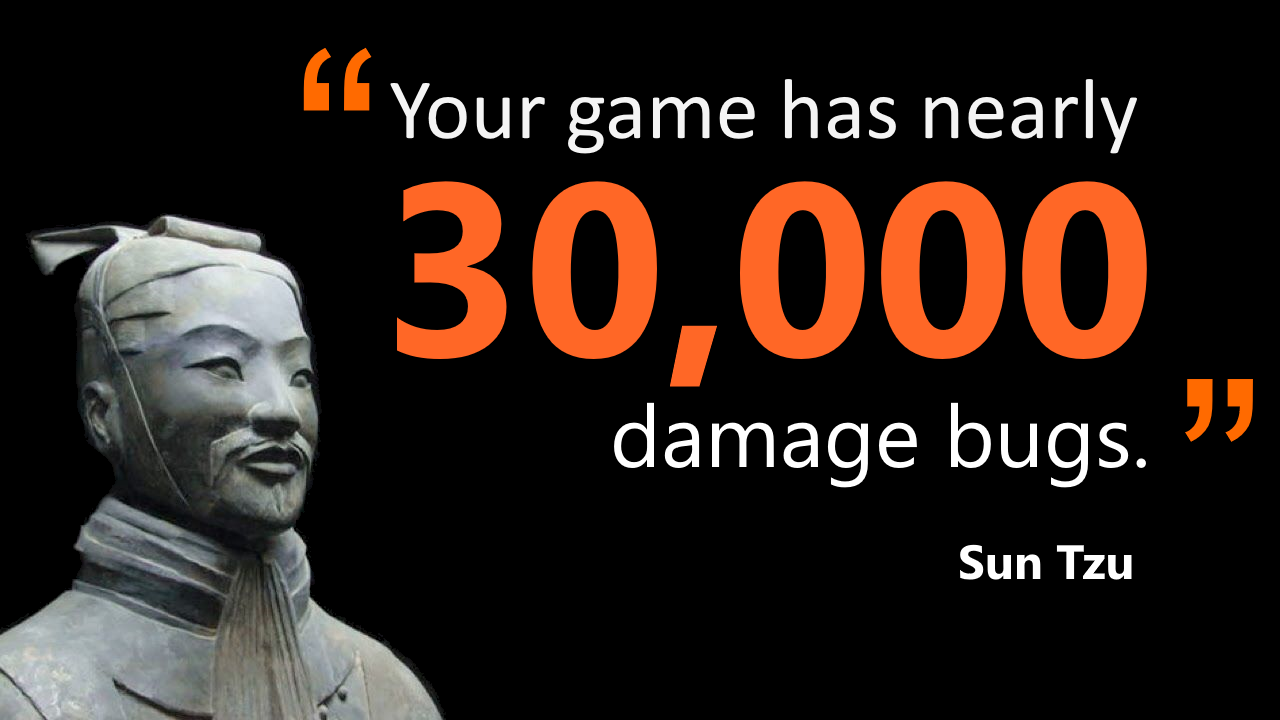
CBP and the Mongol UUs
Right now in CBP Alpha 9, the Mongol UUs have these changes that were introduced wayyy back in Alpha 1, the first real version of CBP:
- Nerf: Softcoded damage modifier vs Light Infantry
100%-> 85% (works alongside hardcoded 160% modifier to result in 136%) - Nerf: Softcoded damage modifier vs Gunpowder Infantry
100%-> 85% (works alongside hardcoded 145% modifier to result in 123%)
Horde (IV) and Golden Horde (V) additionally have these two changes:
- Nerf: Attack recharge
25-> 27 - Buff: Projectile speed
100-> 120
Alpha 1 did one big pass on every unit in the game available in multiplayer to trim off small edges of stats where units did something that didn’t align with what a player would expect from it. The attack recharge of Dragoons (IV) and Carabineers (V) is 30, so having the Mongol UUs attack ~20% faster (in addition to getting damage buffs vs civilians thanks to the workaround for EE’s object mask bug) was thought to be some combination of unnecessary power as well as risk that Mongol raiding could run rampant when Citizen time-to-kill (TTK) was restored to the intended two shots instead of the three that’s present in bugged-EE.
-2 attack speed, like the vast majority of changes in CBP as of Alpha 9, is typically not very noticeable, and at small scales has little impact on TTK. Nonetheless, it’s enough to keep the unit at only 11% faster attack speed over the ordinary ranged cav of the time — much less of a risk for a patch that was going to be receiving most of its playtesting in the wild rather than privately before release. As compensation for the nerf they were given that +20 projectile speed as well, in an effort to increase the reliability of their shots while raiding. The goal of the extra projectile speed was to increase average raiding performance without affecting the best-case raiding performance which was nerfed by the attack speed reduction.
As it turns out, the fear of Mongolian ranged cav rampaging through the countryside didn’t turn out to be much of a concern in the feedback from playtesters, because we didn’t get playtesting from virtually any of the high-skill players we asked for help from, and received almost zero feedback from the other two thousand players using CBP.
That explains why it’s taken so long to do this next part: saying that it’s fine to give them their original attack speed back now. It doesn’t seem as though the higher attack speed lead to them getting out of control as raiders much more than they already might’ve been. Conversely, it turns out that between multiplayer lag, most units having generous hitboxes, and the fairly slow movement speed of Citizens, the extra projectile speed didn’t seem to do much despite it being a not-trivial-on-paper 20% increase. It almost never causes an arrow to hit that wouldn’t otherwise, so to reduce the number of changes that scare people away, it’s scheduled to be reverted alongside the unit’s attack speed.
Of course, the extra attack speed affects not only their raiding performance, but also their normal combat performance. The extra DPS is one of the many factors that contributes to their potentially powerful position in Age V.
As for the damage modifiers, I’d like to quickly provide some additional context on those as well. Changes like this one were tested, and as you saw in the first half of the article, in 1v1 and standard even-number army combat, the UUs don’t perform well against the units they have bonuses against. Back when I was putting together the list of changes to discuss for Alpha 1, I did standardised testing using even quantities and saw the same results shown in this article. Since I was doing a pass on every unit in the game, I trust you’ll understand why it wasn’t practical to do the much more in-depth ~30 hours of testing and writing which I’ve now done for this article three years later, just for four units. At the time we expected that anything missed by us would be picked up by the community, but as you’re perhaps aware, that never panned out.
Let’s do some CBP testing to see where Golden Hordes land if we just restore their original attack recharge and projectile speed, but keep the damage modifiers as is. Note also that both Monarchy and The Monarch are more sensible in CBP as well, with a 15% (total) cost reduction and +2 attack / +1 armor instead of 25% and +2/+2.
Consequently I’m cutting down to a paltry 24 Golden Hordes for this test instead of the prior 25. We’ll match up against the slightly-reactive army of:
- 12x Musketeers
- 10x Fusiliers
- 4x Cuirassiers (attacking from flank)
- 4x Hussars (attacking from flank)
Testing first with Fusiliers lazily placed at the front:
As they should, the Mongols lose. Now, swapping to correct tactical play with Fusiliers held in reserve at the start of the fight instead (noting that the position of Red and Blue have swapped physical sides):
We can see that Red gets a small win. Blue isn’t playing tactically correctly though, as none of the GH are trying to expose flanking hits. Remedying that with some basic, low effort flanking:
We see that in this paradigm, we end up with the result that we want: whichever player makes the right compositional choices and then correctly utilises those units wins the fight. Because of this I currently favor retaining the existing damage modifier nerfs (or at the very least not drastically changing them).
Whether we’ll actually end up keeping them or not will hopefully be the subject of some of the discussion over the next several months as I prepare Alpha 10.11
Moving beyond “raw balance” and onto game clarity, I think there are more reasons why the Mongol UUs (with the aid of T&P) lead to a bad and unintuitive gameplay pattern if left in their original state.
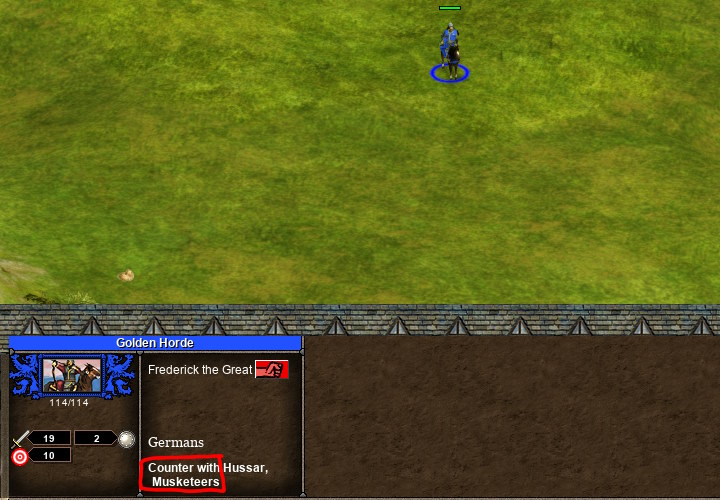
If you face an enemy Mongols player in Age V and click on their Golden Horde, the game will literally tell you to counter with Musketeers because that’s what one of the counters to ranged cav supposed to be in Age V. As we’ve seen, that would’ve typically been correct back in 2003, but now it’s just confusing to play against because it’s only consistently the case if there’s no Monarch around. Not only that, but as far as I can recall this is the only unique unit in the game that is able to stand up to its intended counter because of its bonuses. Other UUs with huge damage bonuses either double down on the units they already counter (e.g., Spanish UUs being disgustingly strong against melee cav), or do something interesting by becoming a counter to an otherwise-neutral matchup (e.g., Roman UUs slicing up enemy HI).
There are a few UUs that, similarly to the Mongol ones, get bonus damage against the unit(s) that counter them, but it’s never enough to overcome the starting deficit. For example, Inca UUs aren’t actually effective against melee cav, they’re just less bad than other LI are. Put them into either an even number or even-cost fight against same-Age melee cav of either type and they get slammed even without any Monarch-boosting shenanigans.
As we’ve seen, using the Mongol UUs effectively as the player is also not necessarily intuitive. If the Mongols player reads the unit’s tooltip, assumes that the unit is actually effective against what it says it’s effective against and then uses it accordingly, there’s a fair chance they will be confused and disappointed by the results. Rather than being effective on their own, they actually specifically need Monarchy to reliably meet the expectations set by the tooltip.

At this point the primary reason to revert to the official balance would be “because that’s how it was before”, which I don’t personally view as an especially compelling reason in light of everything. Still, it is a reason, and that may be all that’s required. We’ll see how discussions go, and I’m always open to changing my mind to compelling evidence and arguments — and if I’m outvoted anyway then my opinion won’t even matter.
Loose ends
As you should have come to expect by now, references in this article to damage dealt / received / what-have-you apply primarily to the official, working version of the game’s balance, and secondarily to CBP (though the changes in CBP would alter the outcome for the Mongol UUs a little, as somewhat noted in the CBP testing section). If you play on the Extended Edition with all of its gluttony of literally-broken damage modifiers, then some of the conclusions reached here will not apply cleanly to the game which you play. Nor should it, as you’ve accidentally bought the store-brand knockoff of an otherwise delightfully deep strategy game.
Something I glossed over a lot is why Horde (IV) can’t be used in the same way as Golden Horde (V), despite their shared ability to also be Monarch-boosted. The short answer is that Fusiliers don’t exist yet. A ranged unit is required in order to reliably fend off melee cavalry without being heavily exposed to enemy ranged fire, and it also needs to have some pretty spicy DPS to be effective enough to offset how quickly the Mongol UUs will die otherwise. Elite Pikemen don’t fulfill either requirement.
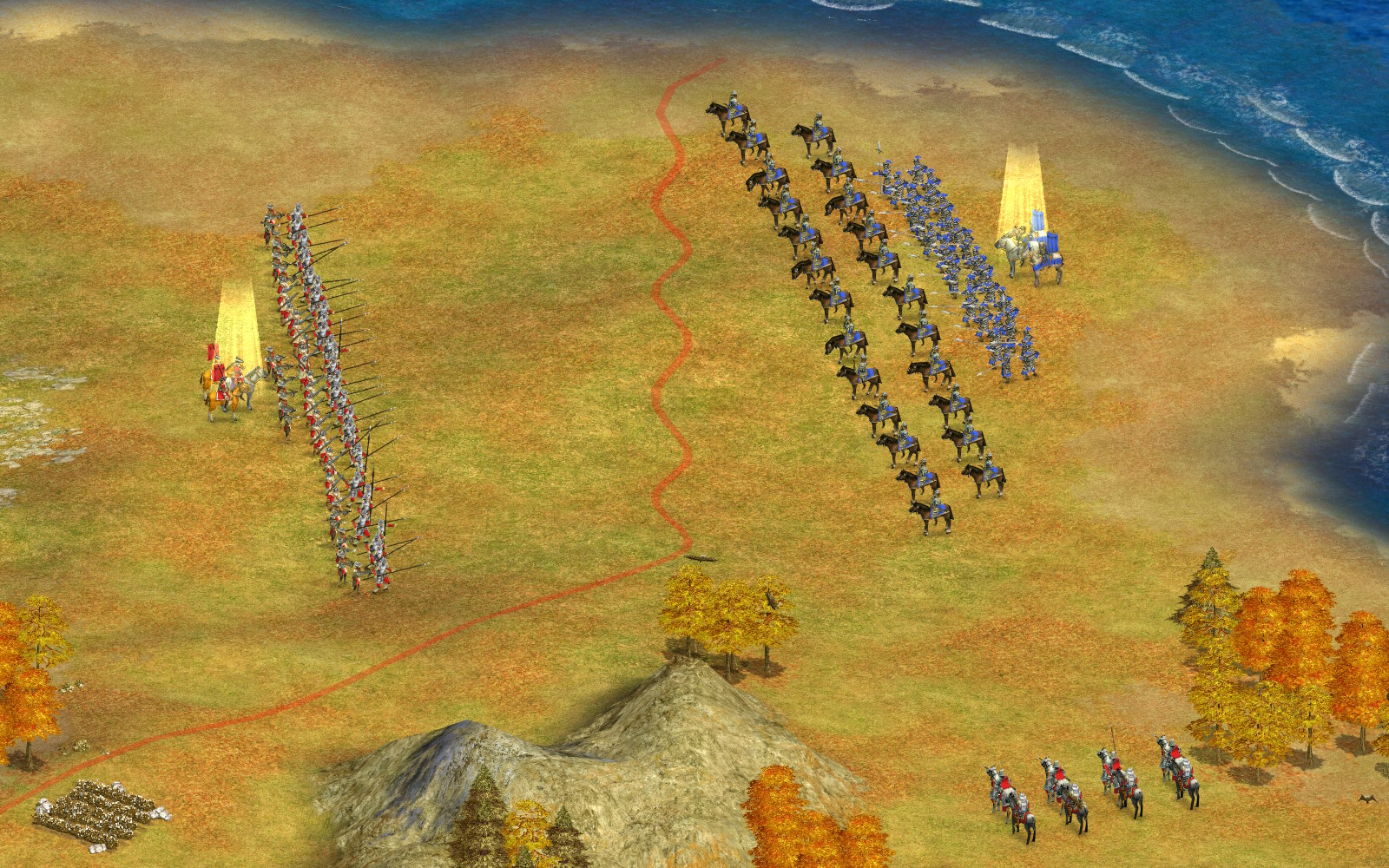
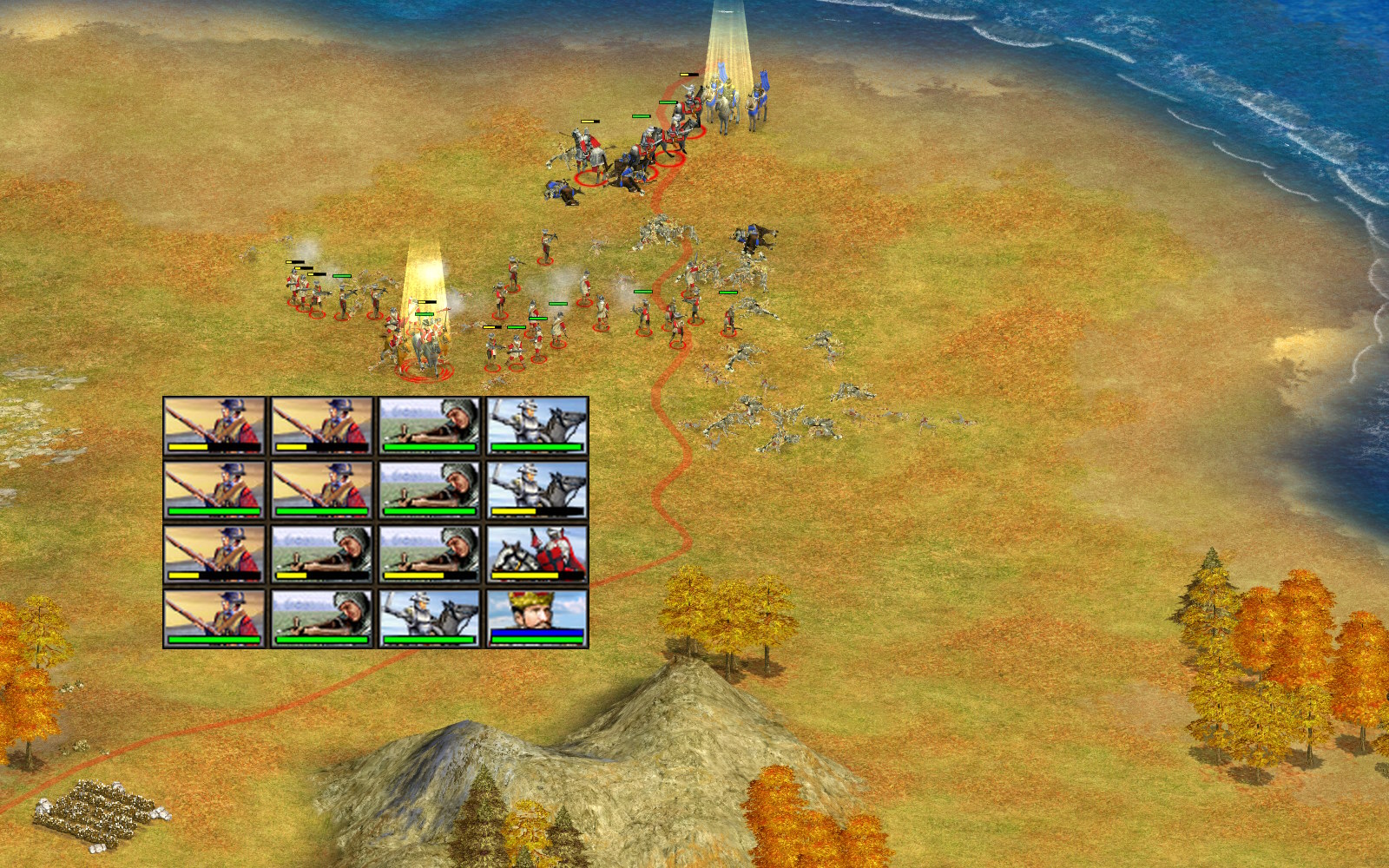
I started out running many iterations of each test and showing the results / reporting the median or average result. As testing continued to provide more and more followup questions I opted to not repeat too many of the tests when it came to army-vs-army combat. This means that the screenshots shown may not as accurately represent a typical result, but for anything that seemed surprisingly good/bad I did make sure to test more. This is already the longest RoN article I’ve ever written and it only covers four units (and on top of that only briefly covers the first three!) — something had to give, and I decided it would be this.
There’s also the lingering question as to whether there’s any net-positive value to having these kinds of “confusing at best, useless at worst” damage modifiers for matchups a unique unit is already countered in.
Some people will ask what the deal with the Nubian HA UUs are. They have the same damage bonuses which the Mongol UUs do, except the bonuses are smaller,12 they don’t have the Mongol nation power bonuses (reduced cost etc), and they have the standard 30 attack recharge and 150 degree firing arc. Doesn’t that just make them almost worthless as UUs given that they have no chance in hell of actually standing up to the units their damage bonuses apply to?
Wellthat’sallwehavetimefortodayOKhavefunbye
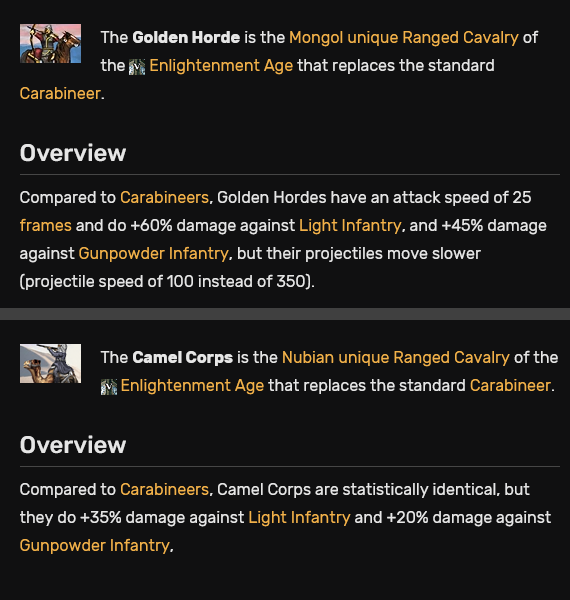
- In reality this bonus creates unit in ~83.33% of the original time, rather than 80%. This is because the progress is literally increased by 20% (final time = 100 / 1.2) rather than the production time being reduced by 20% (final time = 100 * 0.8).
- Many similar situations in the game files can be stated to be unintentional with a degree of confidence based on surrounding context, but that’s not the case for this specific stat.
- (A height advantage as the attacker increases damage dealt very slightly.)
- Reversing the chart would’ve been painful to do because Excel doesn’t support step charts – this is already a very hacky workaround using a scatter plot and took like an hour to make. Reversing the direction would be more work again X_X.
- This is obviously unrealistic, as nobody builds just 10 of one unit and nothing else.
- If your game works, that is.
- The screenshot shows the first result, but the second result also had four surviving Golden Hordes.
- They did receive a single change during their lifetime: a blanket change to all units that can fire while moving — a +15% damage modifier vs other units that can fire while moving — not really a change relevant to this kind of large-scale combat.
- Just in case you were curious, doing 8x Musketeer, 8x Fusiliers, and 12x Cuirassier resulted in a loss only slightly worse than what’s pictured below.
- They weren’t being targeted much and were actually the final surviving Blue combat units, so the attack bonus was relevant but the armor bonus wasn’t.
- I’ve collected a fat stack of bugs over the past year, and also helpfully received some fixable bugs from a couple of other players, so there’s enough material to put out a non-balance-focused patch before CBP goes dormant again.
- Although in CBP they’re equivalent because of the nerf to the higher numbers on the Mongol UUs.

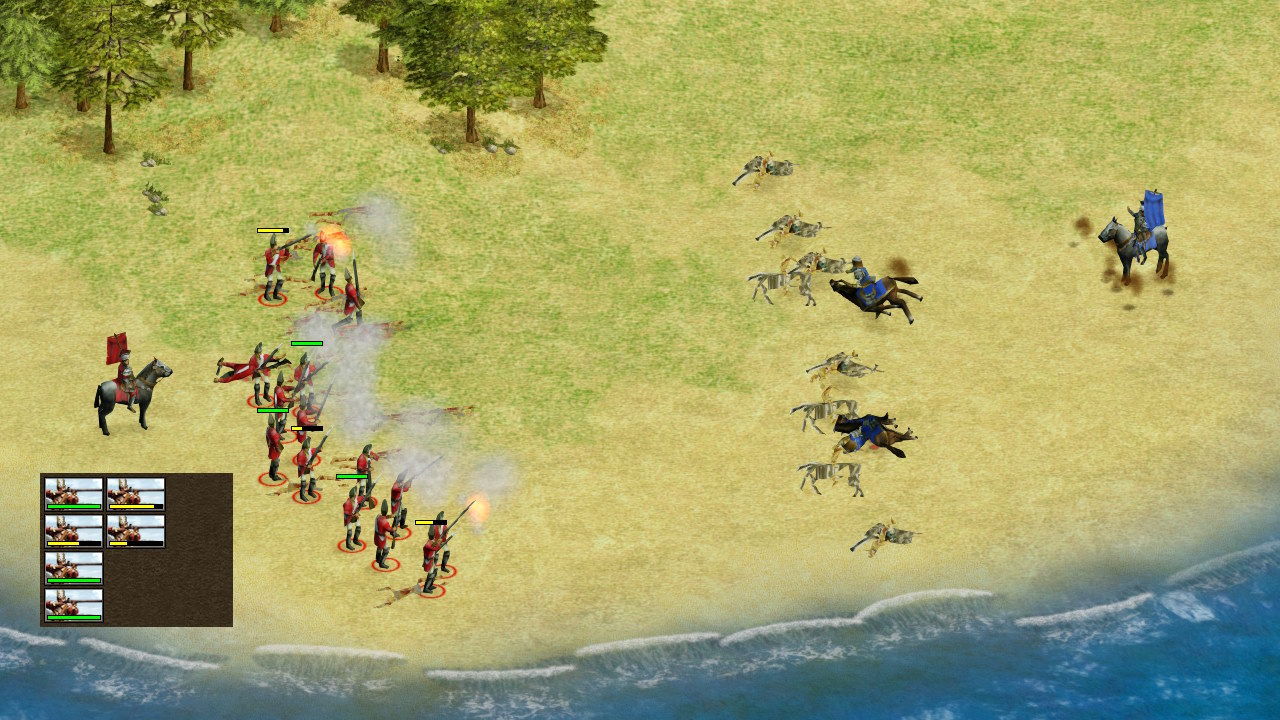
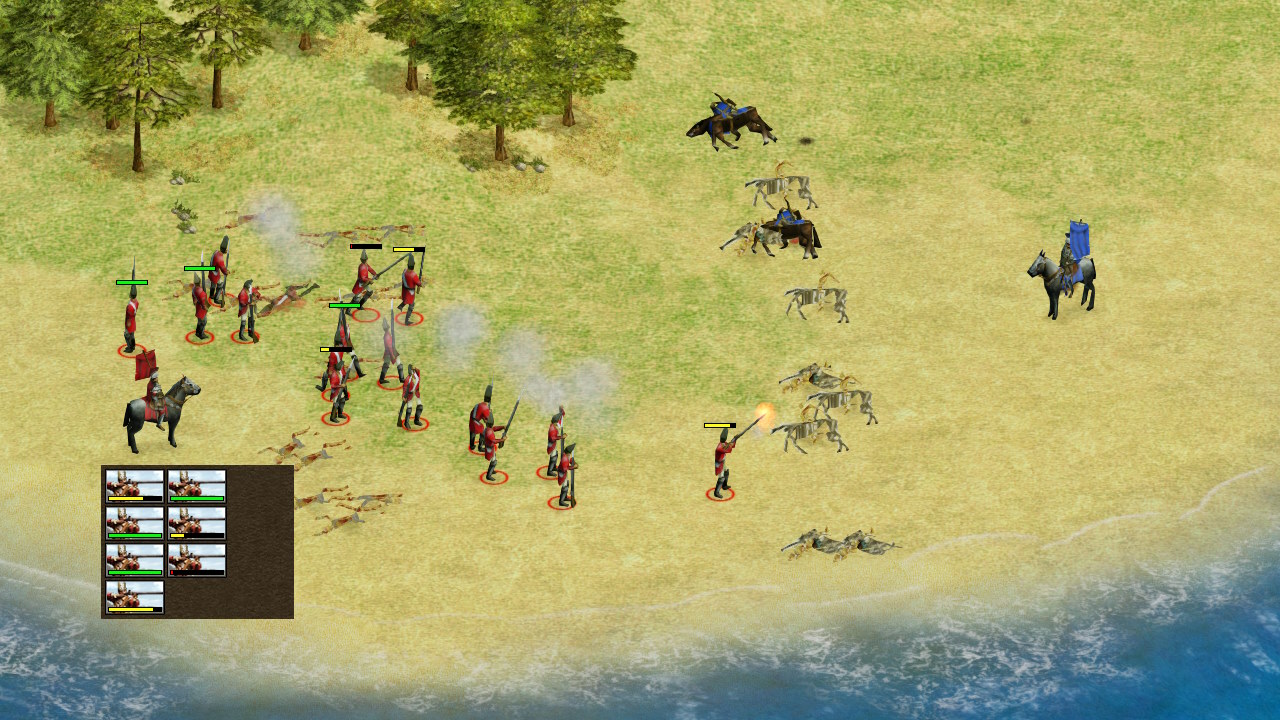
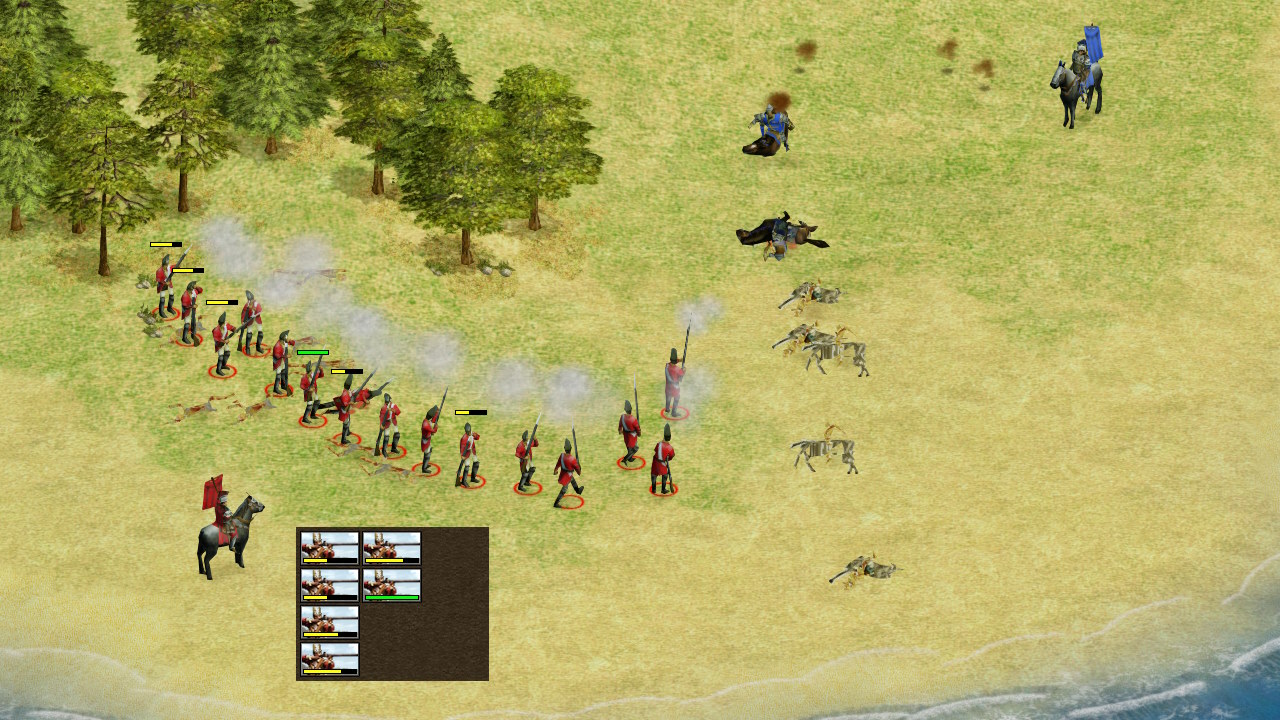
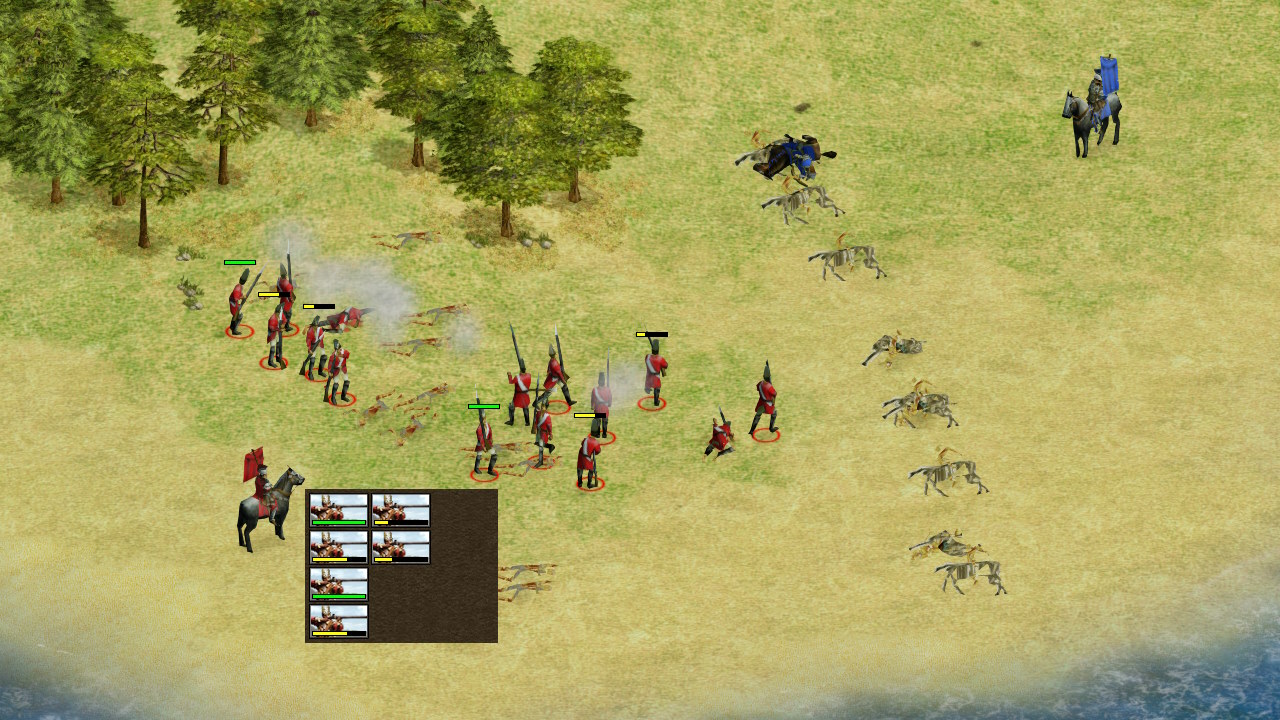

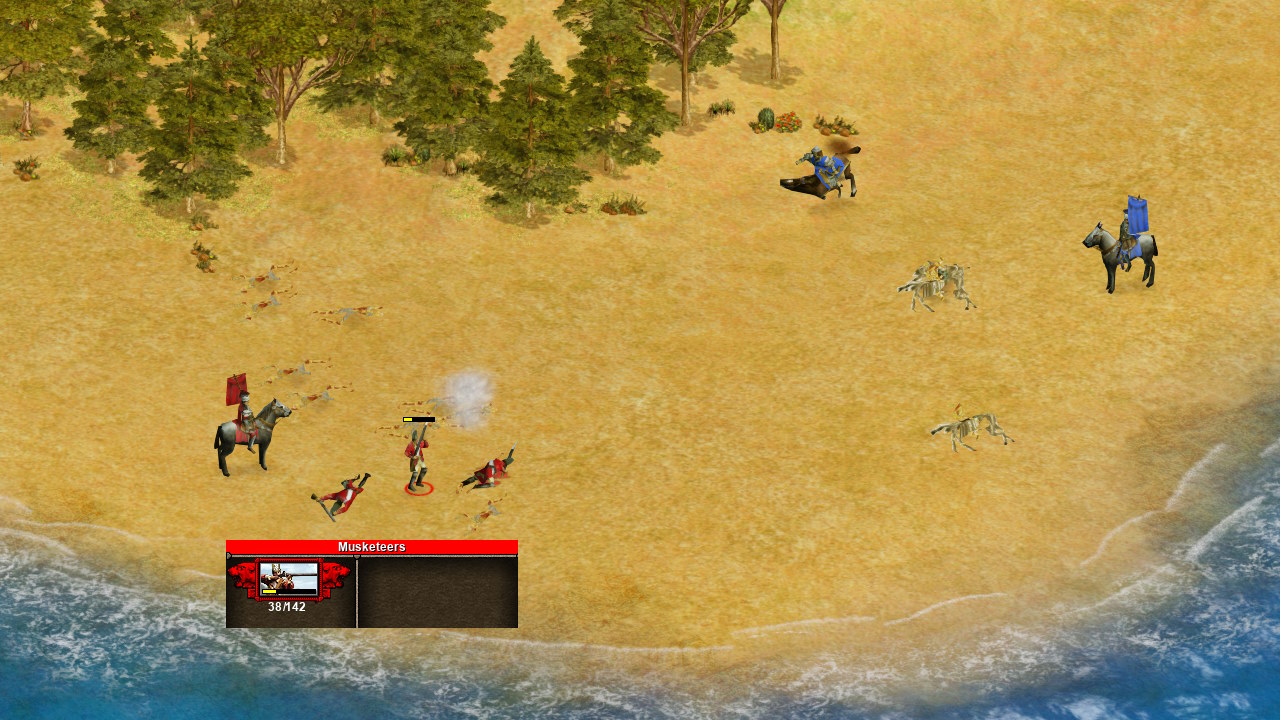
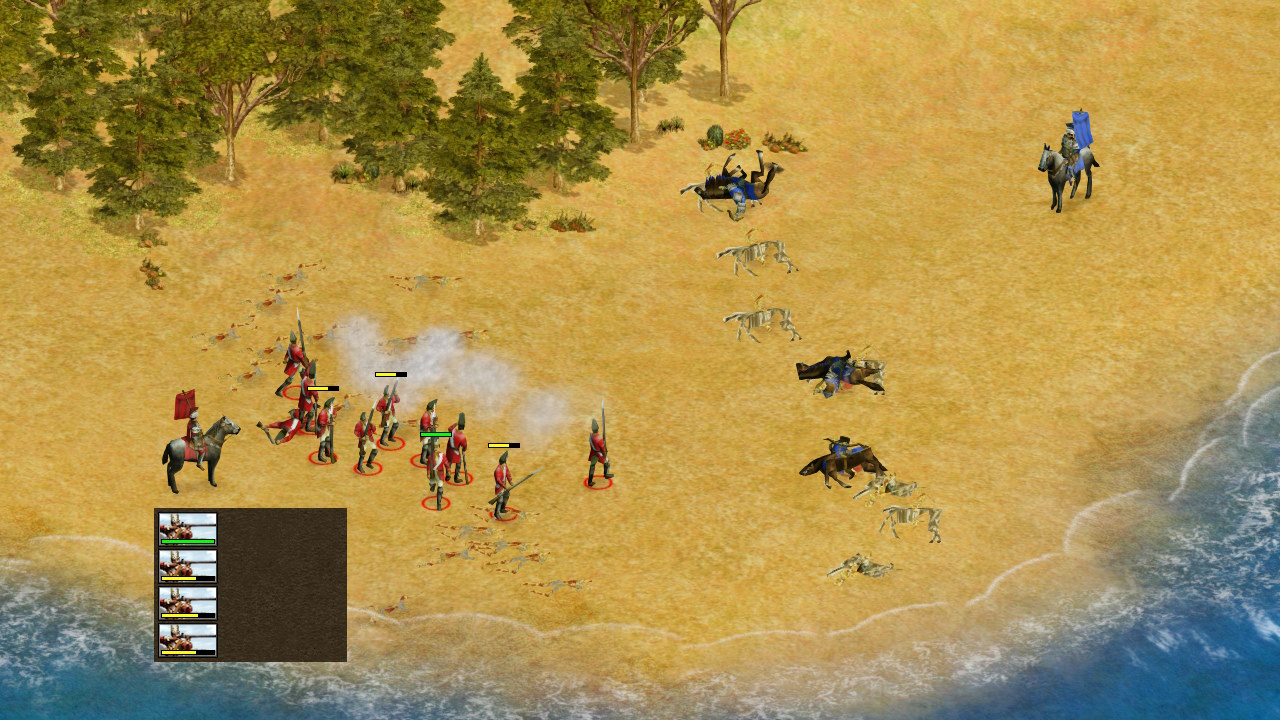
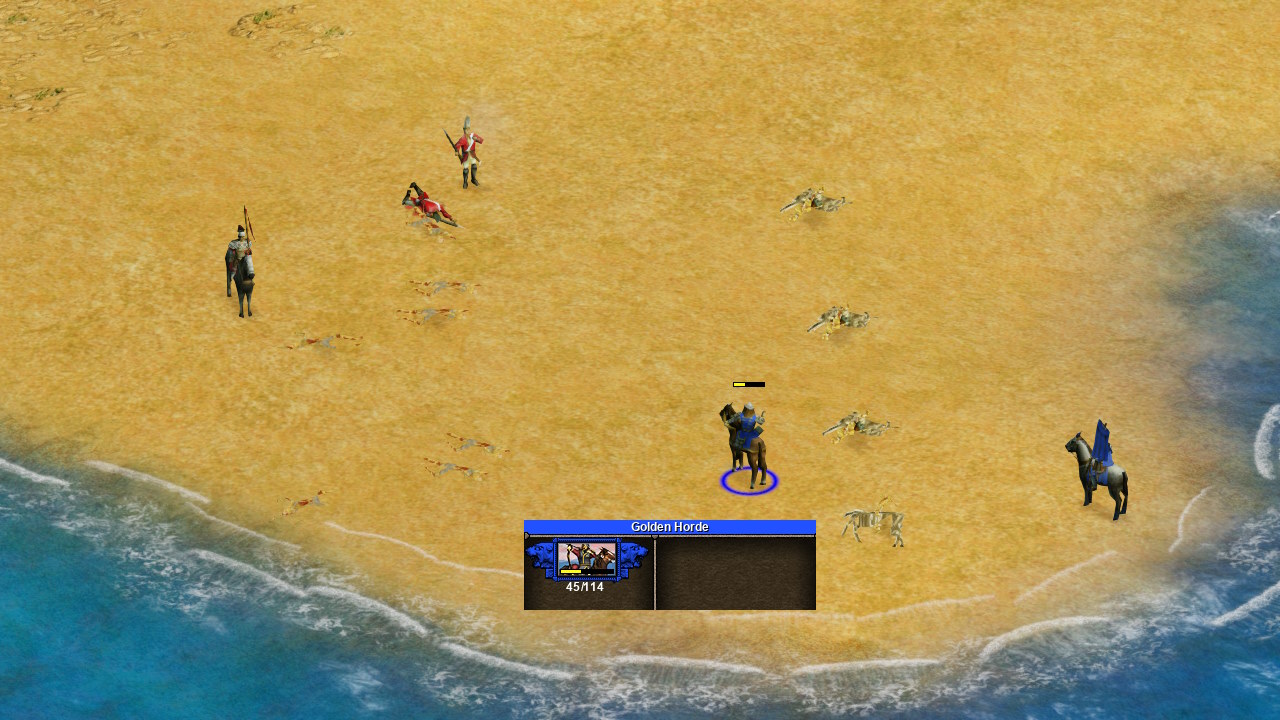
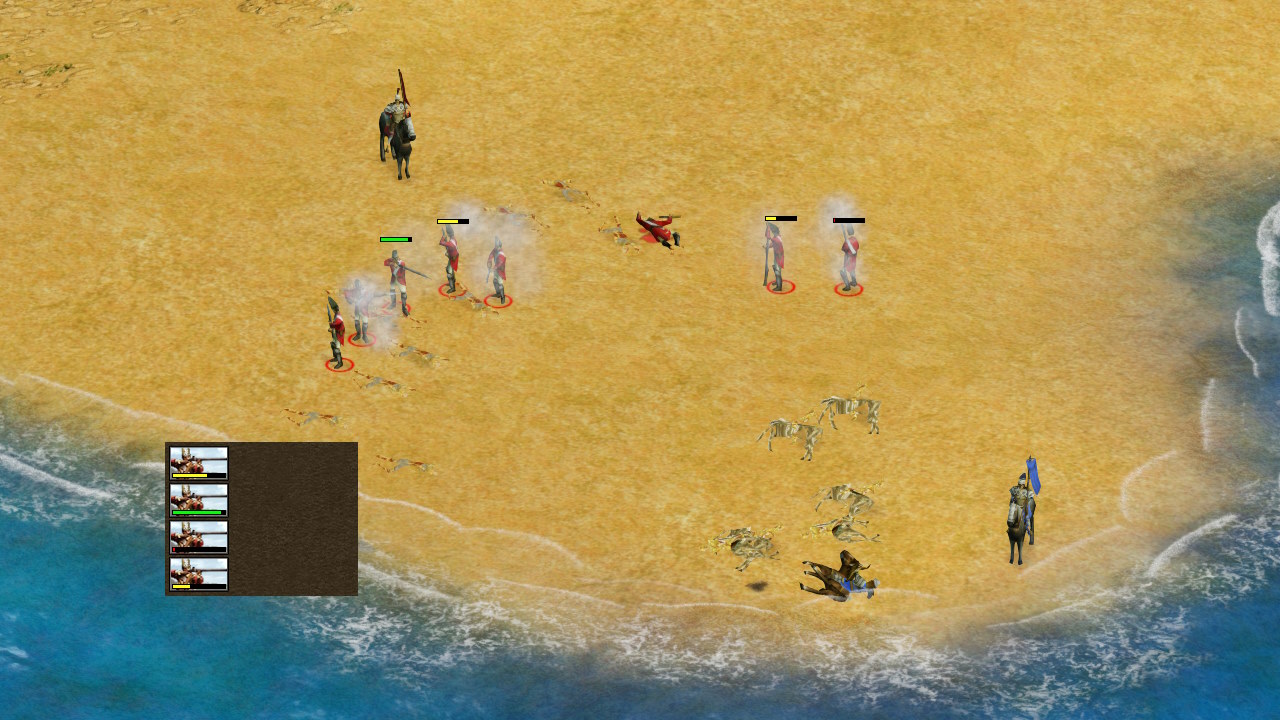



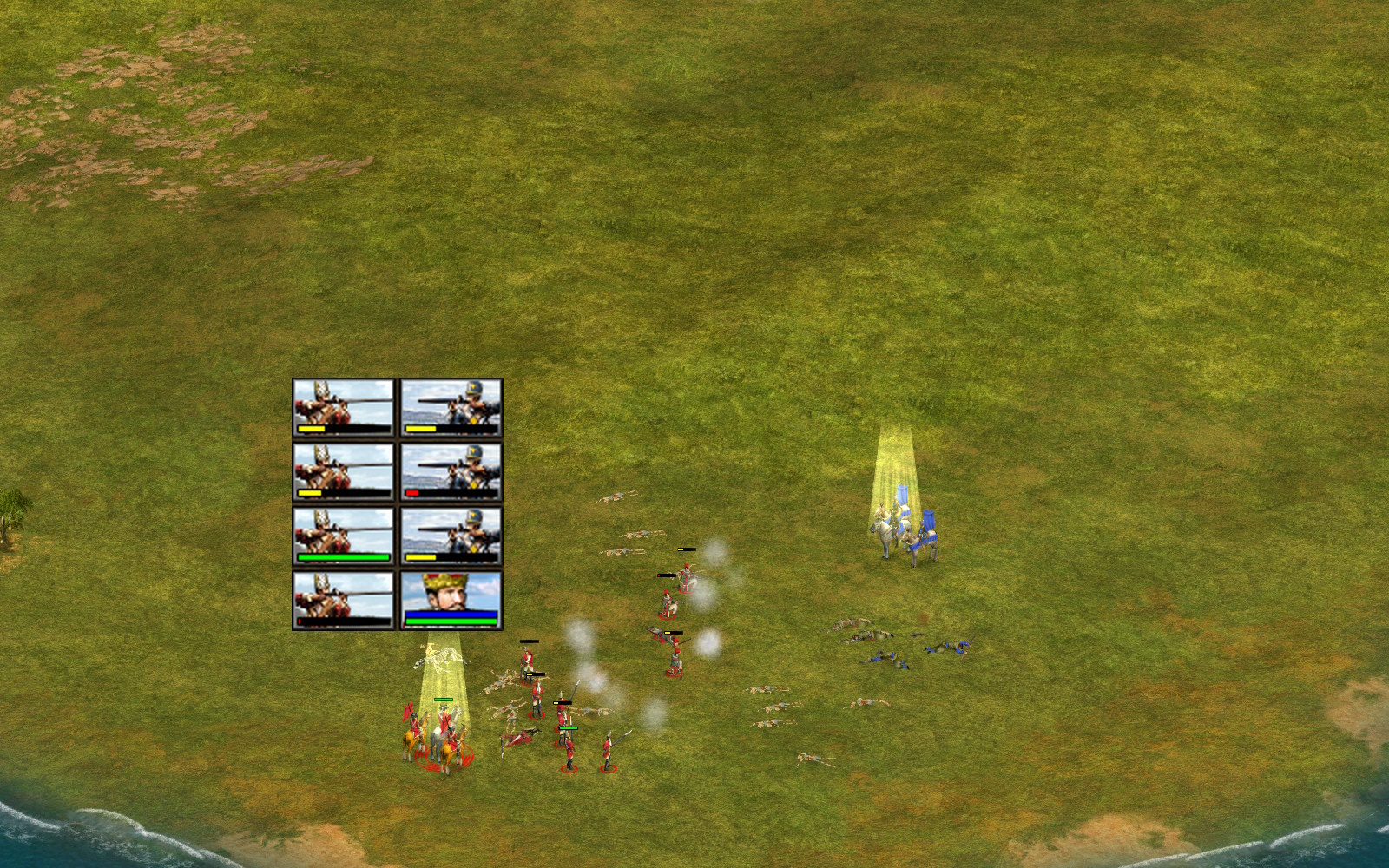

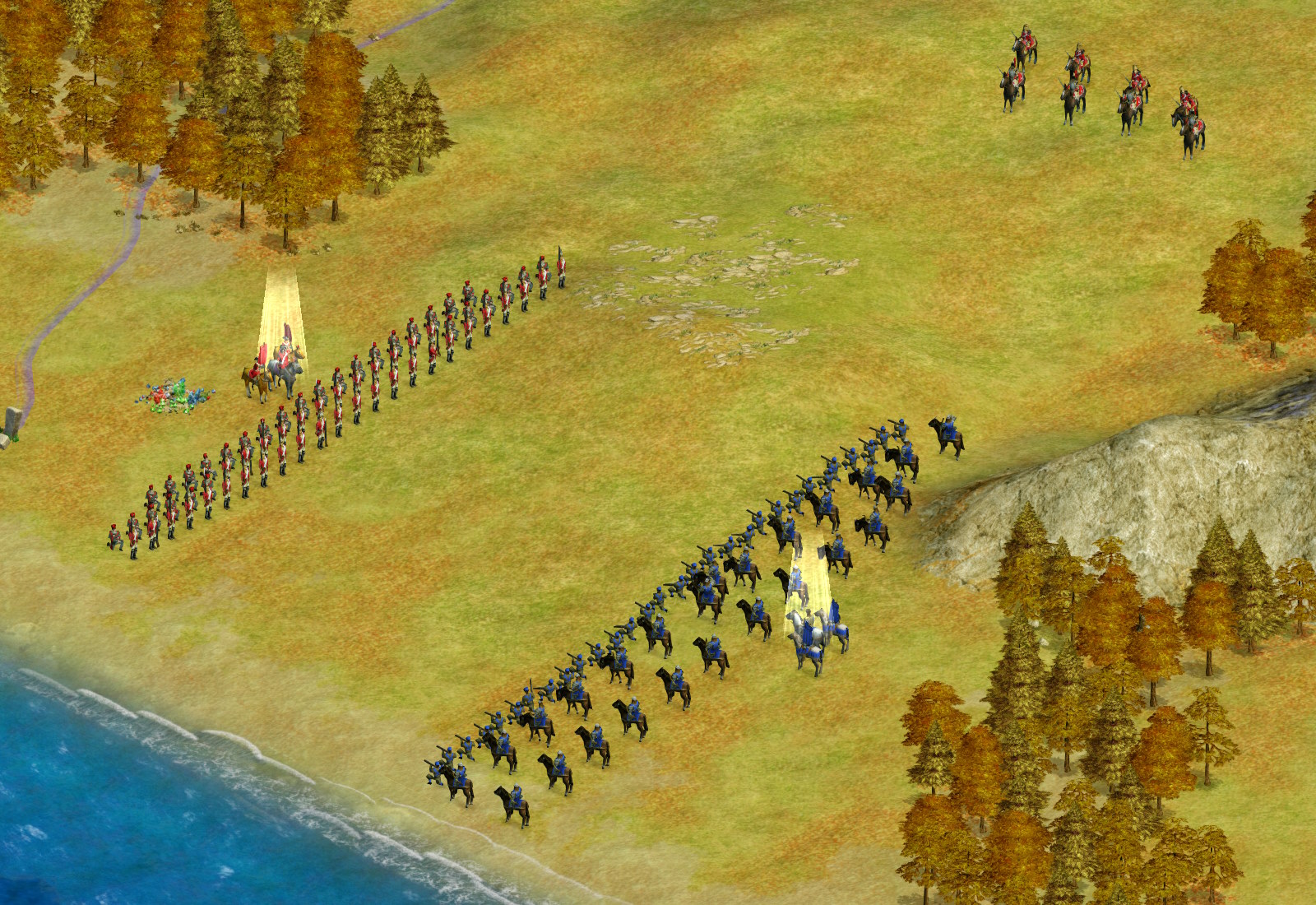
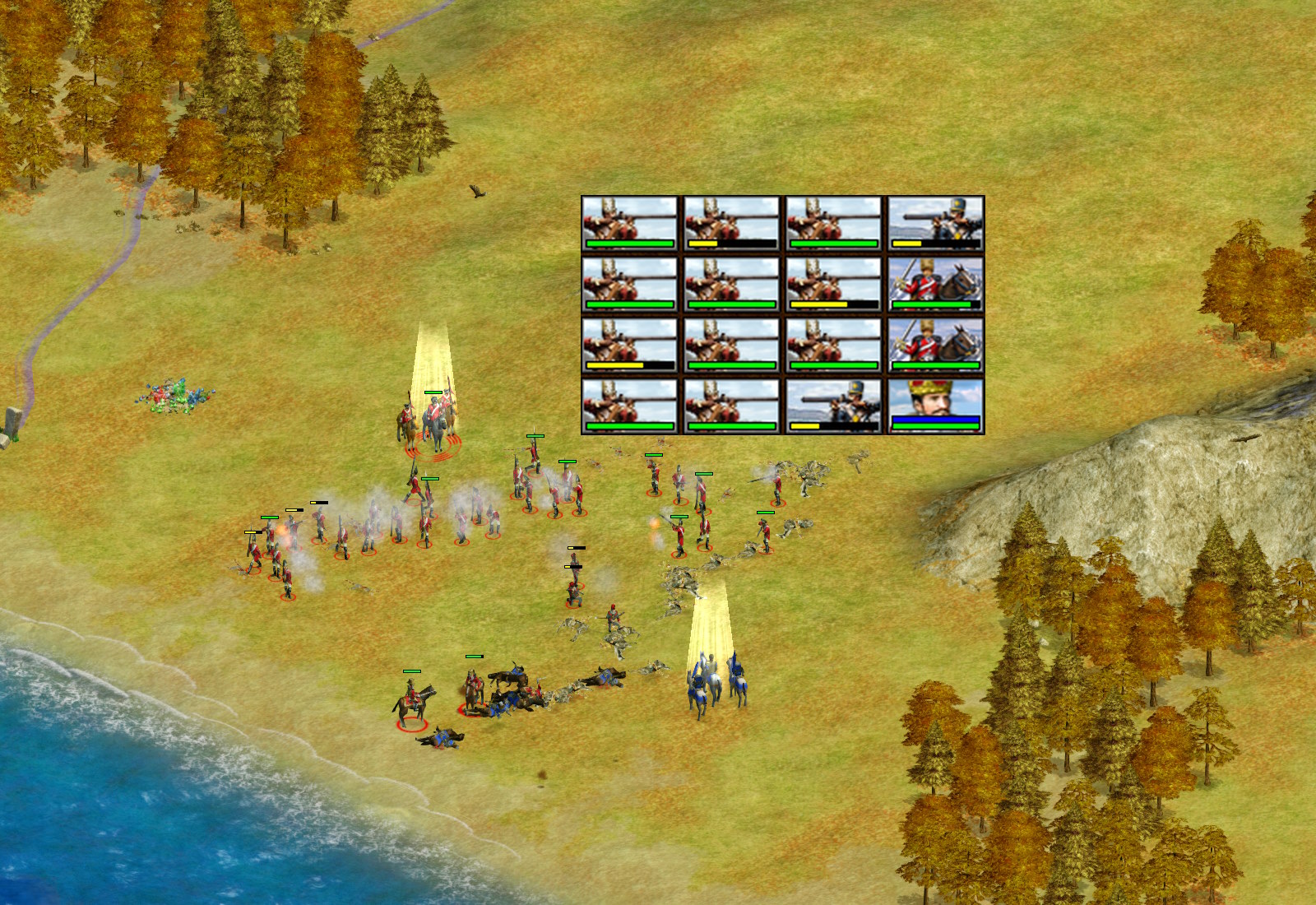
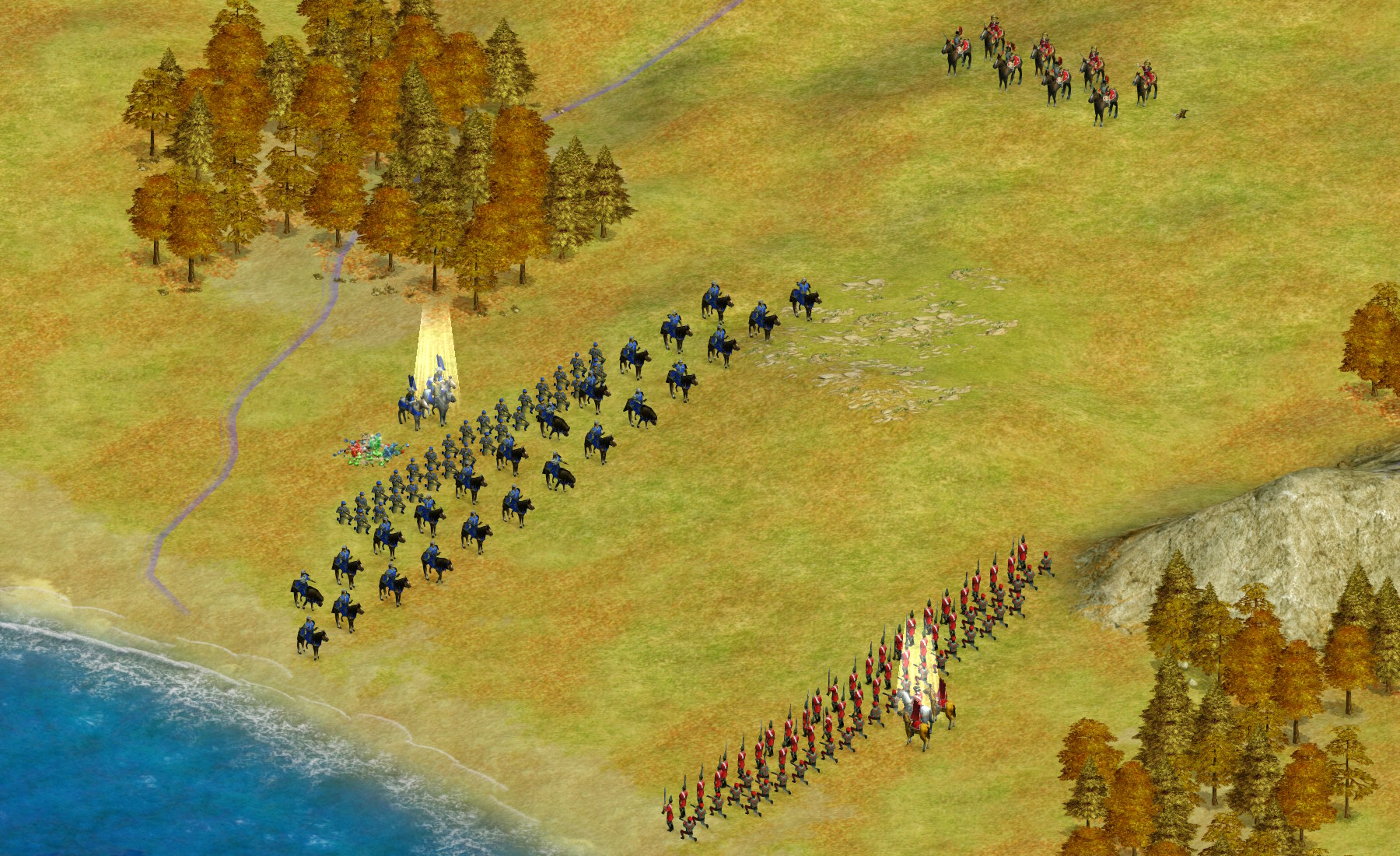
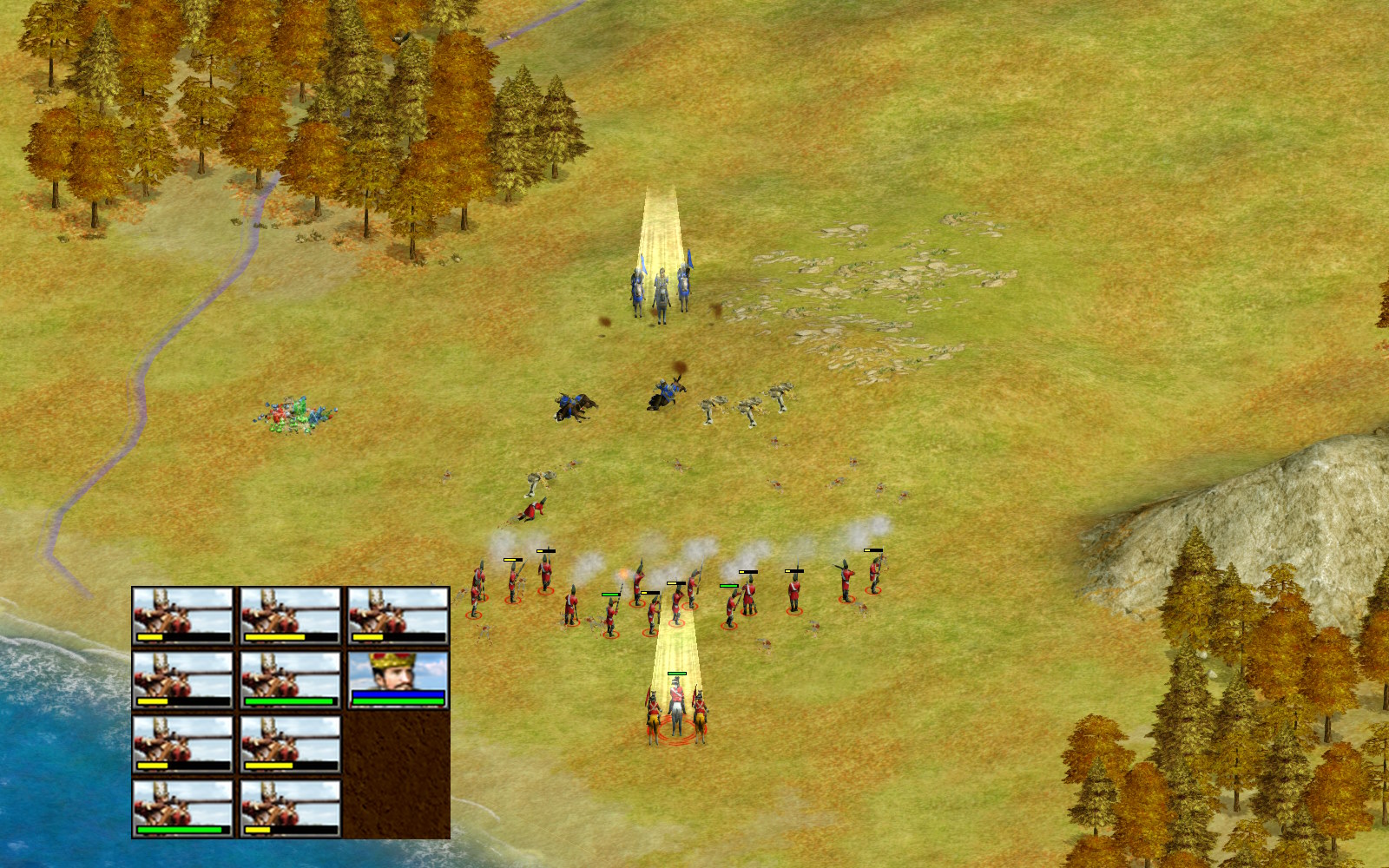


While I admire your dedication, I don’t think people will download a mod to fix this very specific combo. Especially since the game plays perfectly fine with the damage bug, IN FACT, I would argue that the damage bug made the game more balanced (blasphemy I know). Also, there IS a good counter to this,
Mumlukes, which can make short work of all Mongol UU.
The patch is not intended to be a “I want to fix one bug so I will download the patch” situation; it’s a cumulative effect of “I want to fix 30,000 bugs” kind of deal. It takes less than 5 minutes to set up and lets you patch/unpatch in seconds so there is very little effort or overhead required to use it.
You’re of course welcome to your opinion re: balance, but I do naturally think that position is completely absurd and not supported by game design principles (or the original developers, or the original balance testers, or the pre-EE community). I can agree with you that there may be specific matchups where the game isn’t clearly better/worse with vs without the balance bug, but in the aggregate the balance is much worse with the bugs present. Try beating Aircraft Carriers with the damage bugs: it takes more than TWENTY light ships to beat ONE carrier’s planes: completely stupid given that they’re the “counter”. You’re basically saying that the combined efforts of the original developers, the original balance testers, and the pre-EE community made the game worse than if none of them tried to improve game balance.
Mamalukes work fairly well in isolation, but are not a very effective counter for army-vs-army combat. They deal okay damage but take a fair bit in return. The matchup is much worse than just using LC, but of course you do gain the benefit of range making them safer and more reliable. The biggest issue is that Mamalukes’ matchup against Arquebusiers/Musketeers is awful (much worse than Mamalukes -> ranged cav), meaning the Mongols player can just do a split on Arquebusiers/Musketeers and Horde/Golden Horde and any composition you choose that includes Mamalukes will lose to it in an otherwise even fight (unless playing on CBP; I don’t know what happens there). The whole thing also relies on counterpicking the enemy’s nation in the lobby, which is simply not how games are played 99% of the time so it’s not an especially practical counter to bring up (even if it was effective) since it won’t be available in most games.